
® edible NEW MEXICO MEMBER OF EDIBLE COMMUNITIES THE STORY OF LOCAL FOOD, SEASON BY SEASON Farmers ISSUE 84 · SPRING MARCH / APRIL 2023

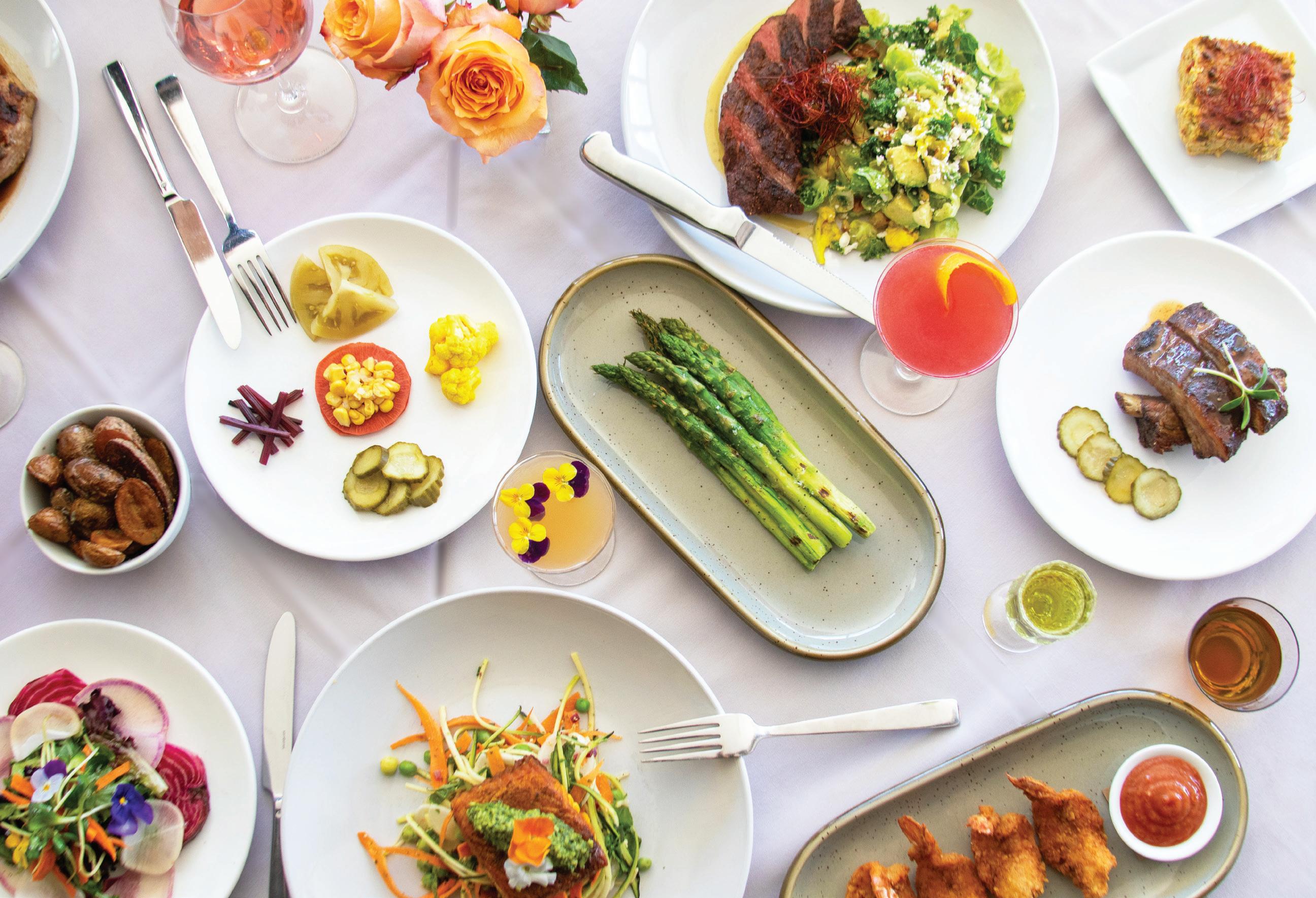
505 CERRILLOS RD SANTA FE . 505.930.5325 radishandrye.com Open 7 nights @ 5pm!




1 EDIBLENM.COM DEPARTMENTS 2 4 6 22 26 32 40 52 GRIST FOR THE MILL By Briana Olson and Susanna Space CONTRIBUTORS LOCAL HEROES
Keibler
Cline,
ABQ,
Grove
FORAGING Yucca Blossoms
Ellen Zachos BACK OF HOUSE New Mexico Staples
Ungelbah Dávila-Shivers FACES OF FOOD Peak Flavors by Candolin Cook COOKING FRESH The Raw and The Cooked by Stephanie Cameron ON OUR COUNTER Community Supported Agriculture 56 72 80 58 68 EDIBLE INGREDIENT Mushroom Ragu LOCAL SOURCE GUIDE LAST BITE Diaz Kitchen & Sushi Bar FARM PORTRAITS Ashokra Farm, Jesus Guzman, Indigenous Farm Hub by Briana Olson and Nathaniel Tetsuro Paolinelli WATER IS LIFE Reflections from a Farmer in Southern New Mexico by Shahid Mustafa FEATURES ON THE COVER
Christina
by Lynn
tiny grocer
Shepherd’s Lamb, The
Cafe & Market
by
by
® edible NEW MEXICO EDIBLE COMMUNITIES THE STORY OF LOCAL FOOD, SEASON BY SEASON Farmers MARCH APRIL 2023 MARCH / APRIL 2023 Santa Fe, New Mexico | 877- THUNDER | Buffalo Thunder Resort .com Scan the QR code to reserve your table at OpenTable.com fine dining | finer wine | finest experience
Crudités. Photo by Stephanie Cameron.
PUBLISHERS
Bite Size Media, LLC
Stephanie and Walt Cameron
EDITOR
Briana Olson
ASSOCIATE EDITOR
To be a farmer in the here and now means existing at a time when the average age of a farm producer in the United States is fifty-seven years old. It means competing in a field increasingly dominated by robots and consolidation. It means going against the grain, choosing the outdoors, the tactile, the scent of onions freshly pulled from the earth. It means, more than ever, adapting to a constant state of uncertainty and change.
In this issue of edible, we celebrate the people who commit to that labor. In particular, these pages center agriculturalists who practice the art of growing vegetables. We visit three farms in north and central New Mexico, each unique in vision, structure, and the cumulative experience of the farmers who tend to it. While there is no “average” farmer, their portraits offer windows into some of the dialogue taking place among local growers. Water, as Shahid Mustafa notes, concerns them—and us—all. Writing from his farm in La Union, Mustafa reflects on the profound uncertainty of the water supply for farmers south of Elephant Butte.
In a survey shared with farmers and CSA programs as we worked on this issue, we asked, “If resources were no issue, what are the first three things you’d do on your farm?” Many answered as you might expect, listing off vital equipment (tractors, coolers, fencing) and sharing a desire to hire more staff and/or give raises. Some want to create space for community or donate more food. And several mentioned goals related to improving irrigation, whether with water catchment, new wells, or drip lines.
“This question will never make sense,” one farmer replied, meaning, for farmers, resources are always an issue. “There is a disconnect,” another wrote, “between the call for more quality local produce and the understanding of the level of resources needed by farmers to answer that call.”
What does it mean to value the vegetables you eat? How can we, not only as individuals but as a collective, better support those growing? We offer a spectrum of answers, from farm-to-table dining options to opportunities for direct support of growers to planting the seed of action: understanding. The results are somewhat like the greens of the cruciferous family—delicious despite being good for you.
Briana Olson, Editor
Susanna Space
COPY EDITORS
Marie Landau and Margaret Marti
DESIGN AND LAYOUT
Stephanie Cameron
PHOTO EDITOR

Stephanie Cameron
EVENT COORDINATOR
Natalie Donnelly
VIDEO PRODUCER

Walt Cameron
SALES AND MARKETING
Kate Collins, Melinda Esquibel, Gina Riccobono, and Karen Wine
PUBLISHING ASSISTANT


Cristina Grumblatt
CONTACT US

Mailing Address: 3301-R Coors Boulevard NW #152, Albuquerque, NM 87120 info@ediblenm.com ediblenm.com
SUBSCRIBE ∙ LETTERS




EDIBLENM.COM
We welcome your letters. Write to us at the address above, or email us at INFO@EDIBLENM.COM
Bite Size Media, LLC publishes edible New Mexico six times a year. We distribute throughout New Mexico and nationally by subscription. Subscriptions are $32 annually. Subscribe online at ediblenm.com/subscribe
No part of this publication may be used without the written permission of the publisher.
© 2023 All rights reserved.
2 edible New Mexico | SPRING 2023
GRIST FOR THE MILL
Stephanie and Walt Cameron, Publishers
Farmers
Susanna Space, Associate Editor
www.blackdiamondcurio.com 219 W San Francisco Street in Santa Fe next to the Lensic apparel kids vintage home books jewelry
CONTRIBUTORS
STEPHANIE CAMERON was raised in Albuquerque and earned a degree in fine arts at the University of New Mexico. Cameron is the art director, head photographer, recipe tester, marketing guru, publisher, and owner of edible New Mexico and The Bite
LYNN CLINE is the award-winning author of The Maverick Cookbook: Iconic Recipes and Tales From New Mexico. She’s written for Bon Appétit, the New York Times, New Mexico Magazine, and many other publications. She also hosts Cline’s Corner, a weekly talk show on public radio’s KSFR 101.1 FM.
CANDOLIN COOK is a PhD candidate in history at the University of New Mexico, freelance writer, editor, and former co-editor of edible New Mexico. She lives in Albuquerque, where her husband owns Vida Verde Farm, and believes in supporting local agriculture and food businesses whenever possible.
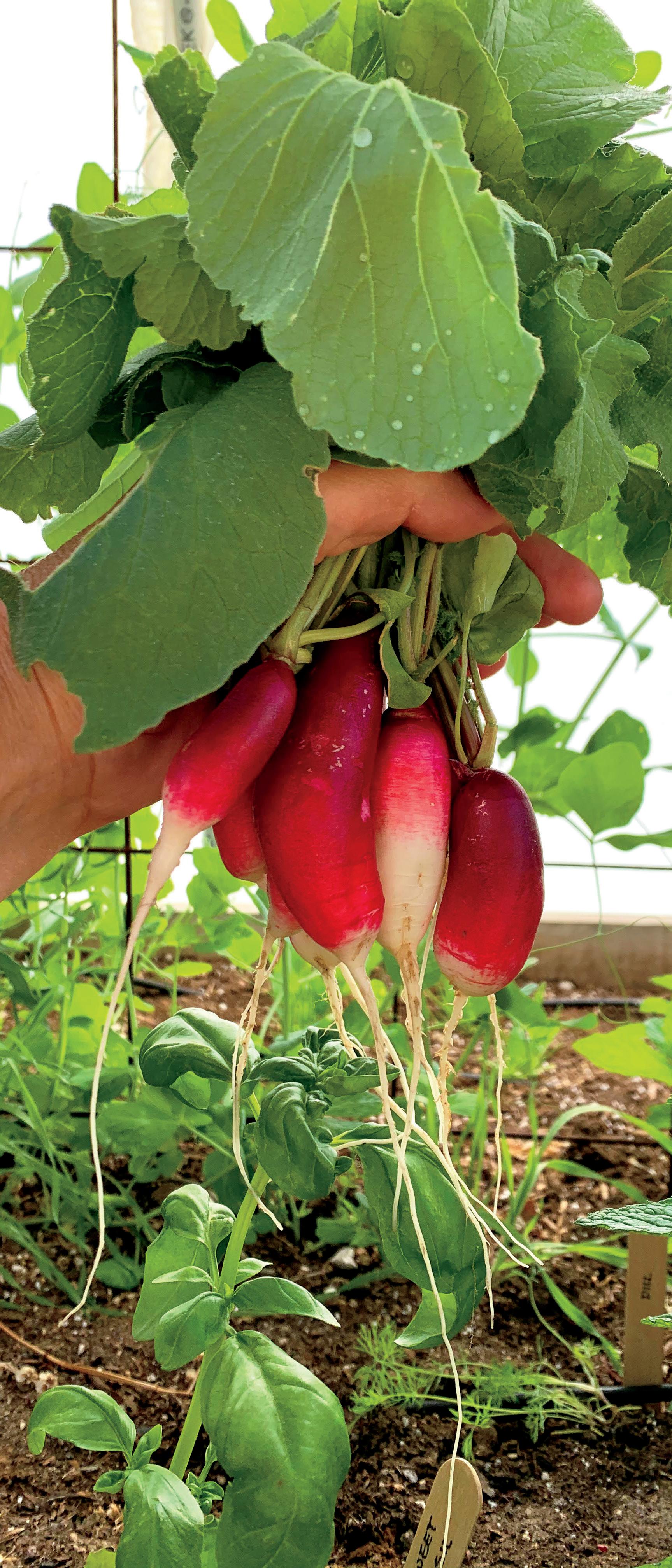
UNGELBAH DÁVILA-SHIVERS lives in Valencia County with her husband, Larry, and daughter, Tachi’Bah. She owns Silver Moon Studio in Bosque Farms.
SHAHID MUSTAFA owns and runs Taylor Hood Farms, practicing regenerative organic agriculture on two acres in La Union and offering a CSA with home delivery. Through his nonprofit DYGUP/Sustain (DYGUP stands for Developing Youth from the Ground Up), he has worked with staff at Las Cruces High School to implement an environmental literacy curriculum and establish a one-acre plot where students receive credit for helping with all stages of vegetable production.
BRIANA OLSON is a writer and the editor of edible New Mexico and The Bite. She lives in Albuquerque.
NATHANIEL TETSURO PAOLINELLI is a New Mexico photographer who documents the people and places around him. He is known for his compelling portraits and unique ability to engage with his subjects to produce images that suggest an implicit trust between artist and subject. His work is in the permanent collection of the Albuquerque Museum and has been published in i-D and Leica Fotografie International
SUSANNA SPACE is a writer and the associate editor of edible New Mexico and The Bite. Her essays on topics ranging from meteors to filmmaking to beluga whales have appeared in numerous literary outlets. She lives in Santa Fe.
ELLEN ZACHOS lives in Santa Fe and is the author of eight books, including the recently released The Forager’s Pantry. She is the co-host of the Plantrama podcast (plantrama.com), and writes about wild foods at backyardforager.com. Zachos offers several online foraging courses at backyard-forager.thinkific.com.
4 edible New Mexico | SPRING 2023
Photo by Stephanie Cameron.
Spring on the farm
There’s nothing quite like spring in the North Valley. As the days lengthen and vegetables, herbs and flowers move from the greenhouse to the fields, there are countless ways to enjoy the season at Los Poblanos.

Seasonal treatments at the Hacienda Spa
Luxurious guest rooms
Restorative yoga and meditation classes
Field-to-fork dining at Campo
Elegant Afternoon Tea
Inspired shopping at the Farm Shop
Visit lospoblanos.com for all our seasonl offerings and upcoming events.
photo: Maura Jane Photography
LOCAL HEROES
An edible Local Hero is an exceptional individual, business, or organization making a positive impact on New Mexico's food systems. These honorees nurture our communities through food, service, and socially and environmentally sustainable business practices. Edible New Mexico readers nominate and vote for their favorite local chefs, growers, artisans, advocates, and other food professionals in two dozen categories. (Winners of the Olla and Spotlight Awards are nominated by readers and selected by the edible team.) In each issue of edible, we feature interviews with a handful of the winners, allowing us to get better acquainted with them and the important work they do. Please join us in thanking these Local Heroes for being at the forefront of New Mexico's local food movement.
OLLA AWARD
By Lynn Cline
The Olla Award recognizes individuals who have made significant contributions in the realm of good food work in New Mexico, and who are creating a more robust local food system. Nominations are submitted by the general public and the winner is determined by the edible team.

Christina Keibler wore many hats at the New Mexico Farmers’ Marketing Association (NMFMA), but her primary focus was making sure that the nonprofit was supporting New Mexico’s diverse farmers, ranchers, consumers, tribal communities, and food-insecure communities. Her way with words and passion for helping others, as well as her joy in sharing her delicious, healthy recipes on the NMFMA
website, endeared her to people not just in the farming and farmers market communities around the state but to everyone she met.
“A lot of people called her a shining light,” says Alison Penn, NMFMA’s communications administrator, who was mentored by Keibler and was her friend for the last decade. “They called her a joy, a powerhouse, and a bright soul.”
6 edible New Mexico | SPRING 2023
Farm Shop at Town & Ranch (downtown Albuquerque) 1318 4th Street NW
Farm Shop (Los Ranchos de Albuquerque) 4803 Rio Grande Boulevard NW
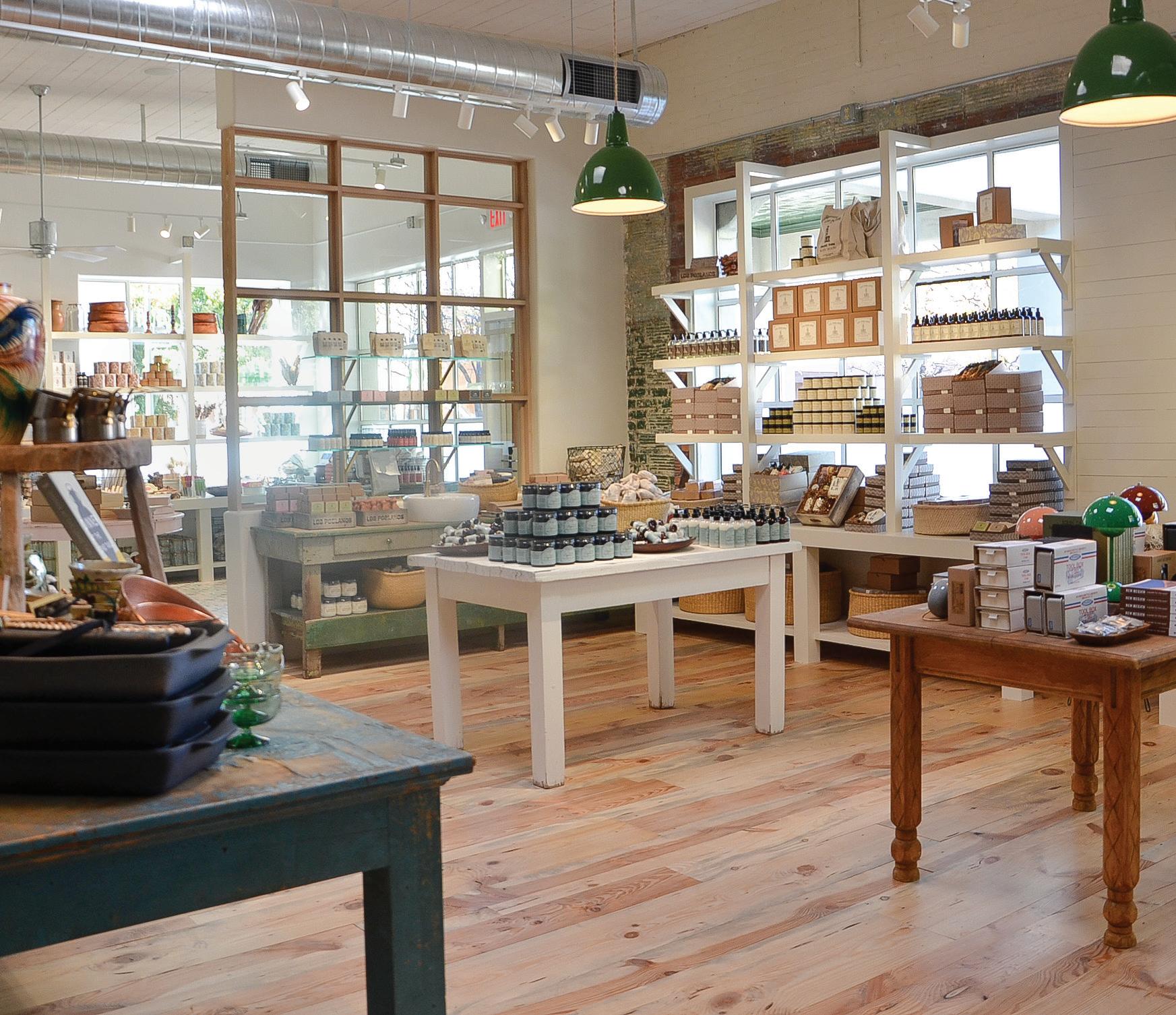

7 EDIBLENM.COM Visit Farm Shop Norte for a unique Los Poblanos shopping experience in downtown Santa Fe. One block north of the Santa Fe Plaza, Farm Shop Norte is housed in a renovated 1935 gas station and farm supply store. This one-of-a-kind environment is a destination for shopping Los Poblanos’ signature lavender products, botanical gin, and Farm Foods, alongside curated objects for the home, and New Mexico wine and spirits. Adjacent, Bar Norte is an intimate space to enjoy a cocktail made with Los Poblanos Botanical Spirits and enjoy a light tasting menu.
Tuesdays through Saturdays, 11am - 7pm | LOSPOBLANOS.COM
A
201 Washington Ave., Santa Fe |
F
R M S H O P
Keibler’s expertise, enthusiasm, and energy played a big role in strengthening New Mexico’s healthy local food community. When she started at the NMFMA in 2014, she brought two decades of experience as a horticulturist, ecologist, and food and culture researcher. She drew from her extensive knowledge in local food systems, farming, sustainability, cooking, and outreach for co-ops, nonprofits, and state agricultural extension services, as well as many other areas. In her seven years at the NMFMA, she helmed a dizzying array of projects, from community outreach and program evaluation to research endeavors, educational content creation, website management, and helping consumers get information about Double Up Food Bucks and other nutrition incentives.
“Christina was very community minded, and the NMFMA and the whole farmers market community was the perfect place for her to fit in,” says Sarah Grant, the now retired cofounder of the NMFMA, which strives to strengthen the local food system by supporting agriculture producers and networks that build a healthier New Mexico. “She was hired as a part-time person and very quickly became full time. Having Christina helped the organization grow. She did a lot of research for [programs funded by] grants. She was very patient and good at learning new technology. She was a big part of improving our social media. She had an amazing amount of interests, like being an anthropologist, and she was super interested in farmers and farmers markets.”
Keibler, who grew up in Chicago, earned her master’s degree in cultural anthropology from the University of Kansas, and also held degrees in natural resources ecology and conservation biology and horticulture. She was a painter, a photographer, and a belly dancer, part of a Santa Fe circle of dancers closely woven together through friendship.
“Christina was a pioneer woman,” says Denise Miller, executive director of the NMFMA, who worked closely with Keibler. “She made cheese, made her own paints, created her own belly dancing costumes, fixed her windows, grew food in her garden, and more. She was fiercely independent and a true free spirit.”
Surveying the NMFMA’s some two hundred active members— farmers, ranchers, farm stands, grocery stores, and farmers markets—
was a major part of Keibler’s work. “She was in charge of all the surveys,” Penn says. “We do several throughout the year, but the important one is our membership satisfaction survey, and that’s where she gleaned a lot of information on how we were serving the communities and what gaps there were. She was able to problem solve,” Penn says.
At the same time that Keibler was working to strengthen a local food system that supported farmers and consumers with affordable nutritious fare, she found time to pour her love of local food and cooking into the NMFMA blog, sharing her recipes, photographs, and musings such as “Five Ways with Frugal Food Scraps,” explaining how to use minced vegetable scraps to make tortillas and pizza crusts.
“Her true love was the recipes,” Penn says. “We have a bank of about two hundred recipes on our website and a lot of them are Christina’s. They are original. She thought a lot about using ingredients that were culturally relevant and commonly available in New Mexico. That was her passion project.”
Carrie Nash, a close friend and fellow belly dancer, spent a lot of time at Keibler’s home. “I’m not a cook, so generally I would just bring her some flowers, and she would feed me the most incredible food,” she says. “Most of the time, we’d eat in Christina’s kitchen. I don’t eat meat, and she would always find a way to make food for me, and to make something taste like it was meat when it wasn’t. She loved making desserts. She made just the most incredible food. She was so intelligent, so intellectual in so many ways, but she came across as incredibly kind, loving, and supportive.”
Keibler passed away on March 11, 2022, at age fifty-three, from complications related to COVID-19, leaving her coworkers, friends, and everyone else who knew her shocked and brokenhearted. Yet the kindness and love that she shared lives on, through her work and her friendships. “She approached everything from the heart,” Penn says. “She was deeply in love with her life and her work, and I think if more people exemplify that, our world will be a better place.”
Reading aloud a thought that Keibler once shared with her, Penn finds comfort and grace, even in the midst of grief: “I like to think that the legacy we really leave after we are gone is how we help to improve other people. We may be gone but our impact remains, like ripples in a pond.”

8 edible New Mexico | SPRING 2023

9 EDIBLENM.COM A N A S A Z I RESTA U R A N T B A R & L O U N G E ROSEWOOD INN OF THE ANASAZI | 113 WASHINGTON AVENUE | SANTA FE, NM 87501 | (505) 988-3030
FOOD SHOP
AN INTERVIEW WITH LIZ GAYLOR, OWNER
Photos by Stephanie Cameron
“Eating seasonally from food grown nearby allows you to eat simply. Fresh food tastes better,” says Liz Gaylor, owner of tiny grocer ABQ. “You can taste the terroir, taste the land—you hardly need salt or seasoning—and the spices and herbs add a layer that is the cultural, emotional, and familial attachment we all have to food.” Gaylor was fortunate to grow up in Albuquerque’s South Valley, eating from her mother’s garden and the pear, cherry, apricot, and apple trees that grew there. Her father raised chickens, so they had fresh eggs, and beef shares came from their neighbor across the street. In the late 1800s, three sets of her great-grandparents settled in what would become New Mexico. “My great-grandpa on my mom’s side was a pig farmer and butcher in Mesilla Valley, and my grandpa on my dad’s side had a dairy in Tierra Amarilla / Chama Valley. Nothing tastes quite like my grandma’s lamb roast or my dad’s pot of beans.”

Talk about the evolution of tiny grocer ABQ. What inspired you to move to Old Town Road and enter the partnership with Tuerta?
The original tiny grocer ABQ location, which opened in August 2020, was 149 square feet of retail space and about 153 square feet of tiny kitchen. At the time, I lived a ten-minute walk from Old Town Herbal, a small apothecary I’d opened the year before. There weren’t any grocery stores nearby, and during the COVID shutdown we were all having a hard time finding flour, eggs, basics. Meanwhile, I knew there were so many farmers close by. So I asked my landlord if I could rent the vacant 300-square-foot shop that shared a patio with Old Town Herbal. The basic premise was to support the grocery with a kitchen and café, using food from the grocery to keep a closed loop for minimal waste—and also to provide premade dishes and frozen and canned goods that people could take home, all using local and regionally sourced food inputs. We did what we could while we were in that space, making a lot of soups, beans, some baked goods, and jams and jellies. But we needed more space: I was dreaming of a walk-in cooler and a gas stovetop.
10 edible New Mexico | SPRING 2023
LOCAL HEROES
Liz Gaylor at tiny grocer ABQ.


Pre-order food and coffee for take-out or dine-in @ Iconikcoffee.com Free parking everywhere Amazing coffee, incredible food. 1366 Cerrillos Rd 314 S. Guadalupe St 1600 Lena St
This past year I lived in the back of one of my shops in Old Town. Every morning, I walked my dog by a restaurant that closed down during the pandemic. Needless to say, I called the second the “For Rent” sign went up. The new location has a full commercial kitchen, and last July I was introduced to Liam Kimball, the chef and owner of Tuerta: A Sandwich Shop. He was moving out of his downtown location and looking for a new kitchen. Liam has a similar food aesthetic: local inputs, comfort food. We moved into this new space in August, and combined Old Town Herbal, tiny grocer ABQ, and Tuerta into one home. We have a clinical herbalist on staff seven days a week, and we offer catering and a daily café menu. We’re excited for a summer of special events on our patio!
How do you manage sourcing from so many different local partners, and how does that approach to stocking influence the pattern of your days and weeks?
It’s fun. It’s exhausting. I love all our local farmers and food makers. Because my goal is to play a supportive role, to take the extras that farmers need to move, it does create a varied grocery section: what we stock changes constantly, based on both seasonality and availability.
You’ve offered an abundance of soups since first opening. Why soup, and what distinguishes yours? Any particular soups that customers might want to stop by for during the early-season months of March and April?
I love soup! Soups are so versatile, something to keep on hand for a quick, easy meal that tastes delicious and is super nourishing. Ours are especially nourishing, not only because of the ingredients but because we make our own vegetable stocks and bone broths. Soups are a great way to showcase ingredients or, conversely, to use up ingredients. Luckily, Liam also loves soups and is an excellent soup chef, so our menu always features soups and stews. I try to keep our posole in stock too; I make a red chile pork posole and a vegan mushroom posole verde.
What else is notable about the daily menu at tiny grocer ABQ?
Our menu changes every day, based on the ingredients we have from the farms, and we serve until we sell out. Lunch is served Monday through Saturday, starting at 11 am. On Sunday, Liam does brunch from 9 am to 1 pm and a lunch menu after 1 pm. We serve housemade breakfast burritos (which began as “Morning Show” at Tuerta) every day starting at 8 am. Our coffee bar serves locally roasted coffee, organic milks, plus house-made cookies, pastries, and other baked goods featuring local flour, and a lot of gluten-free and dairy-free baked goods. We also have local kombucha on tap. Beer and wine are coming soon.
Is there a particular influence, person, or experience that led you to root into the local food community?
My mom.
What are you reading? What do you like to read?
I just finished Where The Children Take Us by Zain Asher and The Promise of a Pencil by Adam Braun. I’m currently reading Bonfire Opera by Danusha Laméris. I usually have food books, cookbooks, and herbal books on my nightstand. Right now it’s Claudia Roden’s Mediterranean and a handbook on making essential oils.
Anything else you’d like to share with edible readers?

In March, we’re opening Romero St. Curry & Chai! With Liam’s inspiration, we’re opening a curry house serving fresh-made curries daily, all of which use local inputs—pinto dal, New Mexico chile and mutton vindaloo, rotating vegetable curries, and house-made chutneys and pickles. The chai we serve at tiny grocer ABQ is custom blended for us by Sonia Masocco, a local ayurvedic practitioner, and we grind it in-house and steep and blend it with local honey. Plus we offer samosas and naan made with local flour and regionally sourced hybridized basmati rice.
1919 Old Town Road NW, #6, Albuquerque, 505-705-1601, oldtownherbal.com/tiny-grocer-abq

12 edible New Mexico | SPRING 2023
Left: Liz Gaylor and business partner Liam Kimball, chef and owner of Tuerta: A Sandwich Shop. Right: Tuerta smashburger.
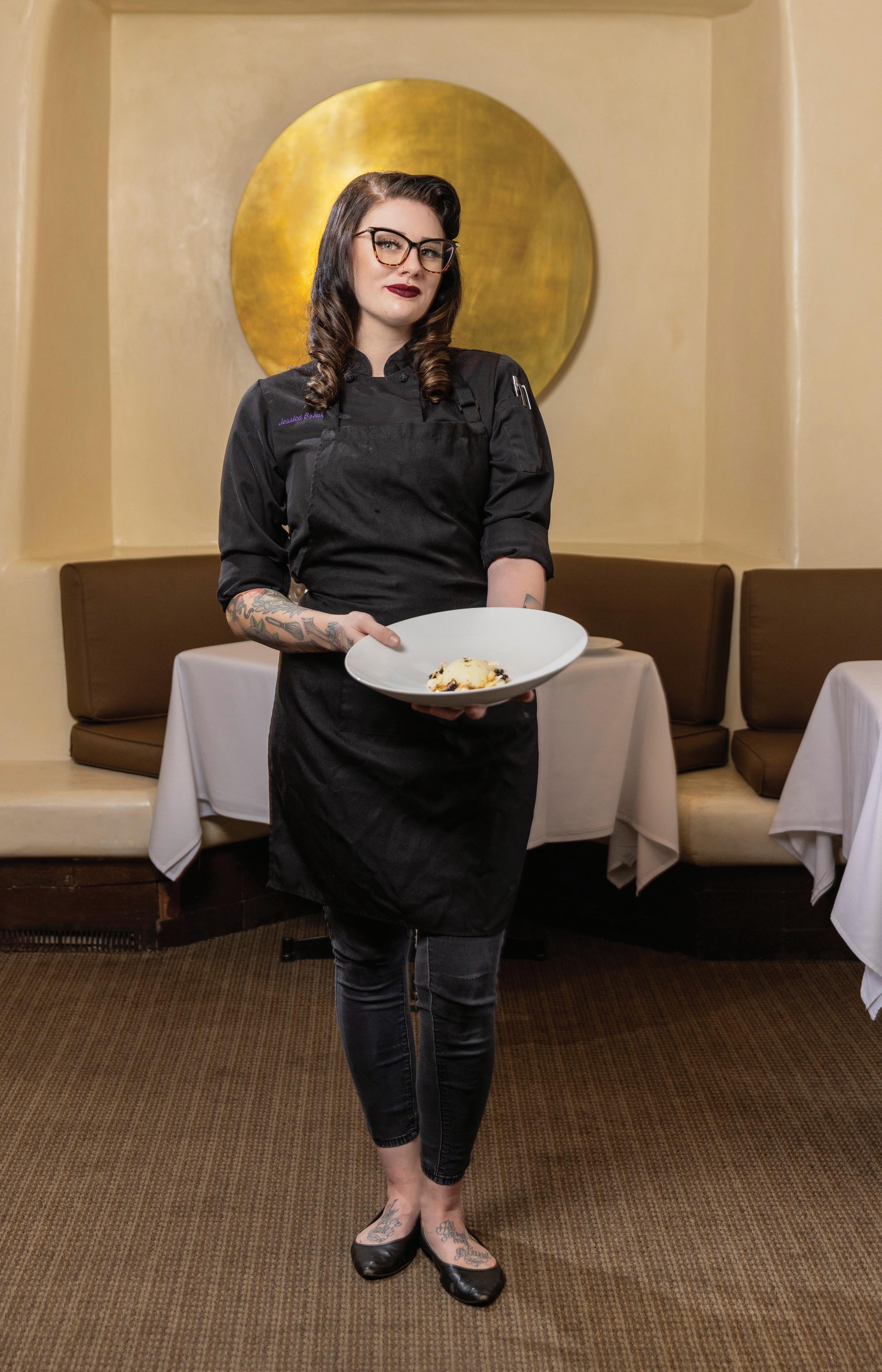
13 EDIBLENM.COM CompoundRestaurant.com 505.982.4353 653 Canyon Road Santa Fe Jessica Brewer lunch • dinner • bar
Chef-Owner Mark Kiffin welcomes New Executive Pastry Chef
photo: Gabriella Marks
FARM/RANCH, NORTHERN NEW MEXICO AN INTERVIEW
WITH MOLLY AND ANTONIO MANZANARES
Photos by Lara Manzanares
The family sheep ranch in the mountains of northern New Mexico is the reason Molly and Antonio Manzanares have never had a vacation. With 750 ewes, that’s understandable. Shepherd’s Lamb produces high-quality lamb and pelts, for sale at the Santa Fe Farmers’ Market, as well as premium wool products including hand-dyed yarn, handwoven items, and wool blankets. Beginning in the cattle business with some sheep, they soon sold the cattle and grew the sheep flock by buying older ewes and keeping the offspring. In time, they started Ganados del Valle, a nonprofit community development organization, and Tierra Wools, a weaving enterprise with a showroom and workshop now located in the cottonwoods of Chama. Both grew up in the Chama / Tierra Amarilla area, Antonio in La Puente and Molly in the Cañones Creek area; Antonio attended UNM and Molly attended NMSU and UNM. The Manzanares have four children, Agustín, Lara, Raquel, and Luisa, for whom ranch life is a firsthand experience.
The history of Shepherd’s Lamb has become quite well known. There’s even a movie about your journey, Los Últimos Pastores What is it like to carry on a generations-old tradition in the face of so much change?
It has been very challenging to keep up old traditional sheep raising with so much change in land tenure patterns in our area. It seemed like many times we were swimming upstream, but we have persevered in spite of many obstacles. We recognize that without the help of family and friends, we might not have made it work.
Can you talk about what’s different about animals ranched traditionally, moving flocks from mountain to pasture, versus meat produced via other farming methods?
What stands out is that the transhumance method seems to provide a large variety of forage for the animals, which we believe results in the flavor that people associate with Shepherd’s Lamb meat. The flock


14 edible New Mexico | SPRING 2023 LOCAL HEROES
Antonio and Molly Manzanares, horses Tomato and Jimmie, and dog Sammie survey the flock during a warm spring afternoon on the ranch.

15 EDIBLENM.COM
is also cared for by an excellent shepherd who lives with them yearround. The lambs spend their whole lives together, all the way to harvest, as opposed to feedlot-finished lambs, who are mixed with lambs from other flocks, which can produce stress.
When you consider what you’ve achieved, what makes you most proud?
We’re most proud of the amount of knowledge we have accumulated over the years in all aspects of sheep production, meat processing and marketing, wool production and wool processing (both through mills and all the handwork we do), and marketing . . . and bookkeeping and business management! We seem to do everything. It is exhausting!
Do you have a favorite time of year on the farm? What’s a perfect day like for you?
Molly’s favorite time of year is lambing in the spring, and then the fall, when we bring the sheep home. Antonio’s favorite time is when the sheep get to the mountains in the early summer: we’re through the hard time of lambing and can see the fruits of our labor spread out and grazing contentedly. Molly’s perfect day is a day spent moving or working the animals on horseback. Antonio’s perfect day is watching Molly have a perfect day.
You raised your children on the farm, and for the most part they’ve chosen different lives than you did. Are there aspects of farming that they enjoyed? What do they like to do when they visit you?
Our children were reared on the ranch and developed a strong work ethic. They have been recognized in their fields. They come to help lamb when they can and to help trail the sheep home from the summer range. It is a family affair.

You’ve talked about your early mistakes as ranchers. As you progressed, was there a particular influence, person, or experience that told you that farming had been the right choice after all?
We just lived and worked and reared our children. It is not until more recently that we have had a chance to reflect on whether or not we chose the right path. There were many times over the years that we wondered what the hell we were doing in this business, but it had been the thing we both wanted to do with our lives and we just kept at it, because we liked the life.
As young people in the 1960s and ’70s, you were both drawn to the land, despite having the choice to live otherwise. Any words of wisdom for young people who feel similarly drawn to farming in New Mexico, or who want to practice traditional kinds of animal husbandry?
To young people now who feel drawn to practice farming or ranching, we would say never look back unless you are planning to head in that direction. Having a good partner and pulling together in the same direction was probably our strongest asset . . . we recommend it. Start small and learn from your mistakes. Read, read, read.
What’s something most people don’t know about Shepherd’s Lamb?
We were probably the first outfit in the West to use guard dogs. Our first ones were Anatolian Shepherds, a breed long used as livestock guardians in Europe and weighing up to 150 pounds, and were acquired from Dr. Raymond Coppinger from Hampshire College.
How’s it going with the dogs? Do you have a favorite right now?
We use herding dogs, border collies, to move our flocks. Our current border collies are Roni, Bert, and Rey. A good herding dog is worth its weight in gold. We also have guard dogs (Pyrenees, Anatolians, and Maremmas); we currently have a really good crew of guard dogs. We recently lost Prince, our very best guard dog. 505-795-3671, organiclamb.com
16 edible New Mexico | SPRING 2023
Molly and Antonio take a quick nap after lunch during the fall sheep drive through the Carson National Forest.



SUSTAINABILITY: WASTE REDUCTION
AN INTERVIEW WITH JASON AND LAUREN GREENE, OWNERS

Owned and operated by Jason and Lauren Greene, The Grove is a breakfast, brunch, and lunch café serving the finest local food in a fun, casual atmosphere. With a team of more than thirty hospitality professionals, The Grove has grown through its seventeen years into a local food landmark in Albuquerque.
The Grove believes in supporting local farmers and sustainable agriculture. Their food is sourced from growers and producers from New Mexico and the greater Southwest. Local and organic products are served whenever possible, and the highest quality ingredients are sourced and served daily.
When brunching at The Grove, you will find a classic menu with cult favorites like their Grove Pancakes and the Farmers Salad. The growing team of talented chefs in The Grove’s kitchen work closely together to create new menu items and seasonal specials that focus on local agriculture and bringing the community together.
The Grove opened in 2006 and has been sourcing from local growers ever since. Can you talk about your relationships with farmers and how you learned to balance consistency with seasonality and local availability?
For us, it’s all about quality, consistency of product, and understanding what we need as a high-volume restaurant. We have farmer partners that understand our delivery time constraints—their communication of available product is super consistent and they are very communicative about how long the product will be available and how much we can get. There has to be a professional relationship there so that everybody wins.
When you talk about community, how do you define yours?
Our community at The Grove starts with our team, how we treat one another under our roof, and what we each bring to the table every day. From there, your vibe attracts your tribe . . . that’s actually in our
18 edible New Mexico | SPRING 2023 LOCAL HEROES
Menu and counter at The Grove Cafe & Market. Photo courtesy of The Grove.




1 2 0 8 R I O G R A N D E B LV D N W, A L B U Q UE R Q UE • C U T B O W C O FF E E . C O M
ROASTERY | TASTING ROOM | COFFEE BAR
Agua
es Vida café es amor
handbook! We feel we have a community of food-loving, quality-seeking guests and team members that understand what we do and why we do it. The Grove is really a gathering place that brings so many different people together for so many different reasons. It’s like home. This award is for The Grove’s efforts to reduce waste—something that restaurants stand accused of producing a lot of. That includes something like 20 percent of the nation’s food waste, along with plastic and other packaging waste, which surged early in the pandemic. When did The Grove start paying attention to waste, and what are some of the restaurant’s strategies for making less of it?
Using sustainable food, practices, and products was a value of ours since day one. Over the years, it has become easier as the city and private companies have begun offering services such as compost pickup and recycling. In the early years, we had incentive programs for our team members to encourage recycling and composting—things like gift cards and cash bonuses for those who would do a run to the compost or recycling facility. Today our composting program and recycling programs are just our way of life at The Grove. We continue to use ingredients, farmers, and companies that choose sustainable practices and quality above all else.
Describe the perfect date-night dinner.
We love a date night. We love doing dine-arounds, where we hit up to three spots in one night. We will start somewhere for a drink and a small bite, then head off to another place where we cozy in a bit more. We like to share everything and order multiple small plates rather than large entrées. The opportunity to sit together over food (and, hopefully, candlelight) and talk about fun things rather than work and life things is just the best.
How do you work on reducing waste at home?
We do our best and are always learning to do better. We do not use
plastic-bottle beverages, we limit paper towel use, we recycle, we use reusable snack bags instead of single-use plastic baggies, and so on. We also garden to help cut down on our produce and flower purchases. What (or who, or where) have been three of your greatest influences?

Lauren: My dad. Not only his love for people and business, but his advice on the big and the small things, remain constant inspirations in my life.
Lauren and Jason: Italy.
Jason: My wife.
Who’s your favorite food authority, local or otherwise?
Edible New Mexico for sure is our local authority. Since we can remember, we grab each new issue and read it from front to back. Good Food Foundation is an authority based out of San Francisco that highlights companies making sustainable food and beverage products without hormones, pesticides, or artificial or genetically modified ingredients.
What’s something most people don’t know about you?
Jason: I dream of leaving it all to live on the beach in the Caribbean making simple, delicious food from only what is local.
Lauren: I have an unusual love for taking walks on snowy trails in very cold conditions. It’s exhilarating to be in the elements. Anything else you’d like to share with edible readers?

We would be amiss if we didn’t say how grateful we are for edible, the team and the readers, for being our voice for good food, farming, and drink in New Mexico. Thank you, all, for the years of support. We love you!
600 Central SE, Ste A, Albuquerque, 505-248-9800, thegrovecafemarket.com
20 edible New Mexico | SPRING 2023
Left: Strawberry shortcake brioche french toast. Right: Sweet potato hash with cauliflower rice, avocado, roasted mushrooms, watermelon radish, and sunny-side-up egg. Photos courtesy of The Grove.
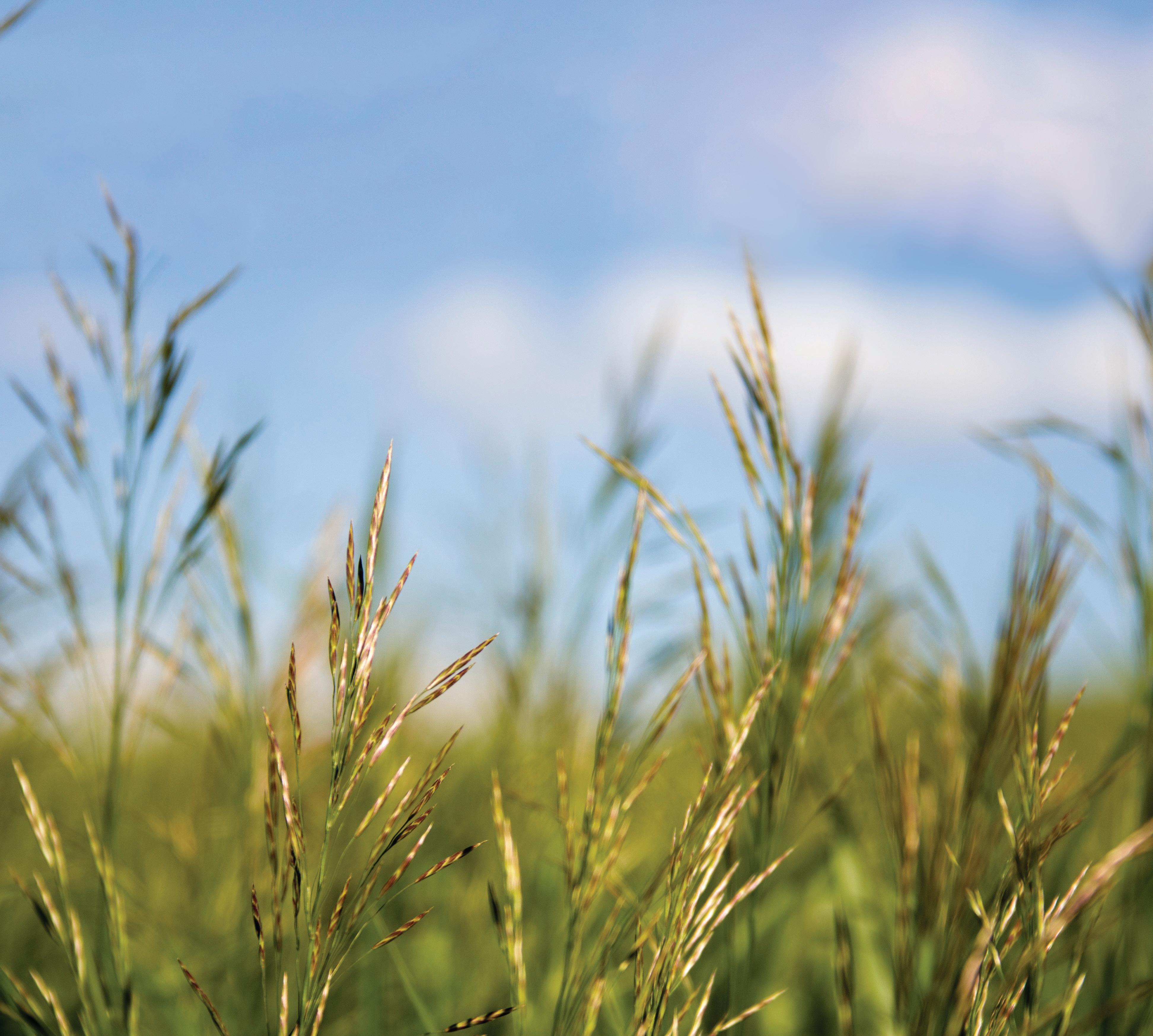






21 EDIBLENM.COM
THEY TASTE AS GOOD AS THEY LOOK
Words and Photos by Ellen Zachos
New Mexicans are lucky for many reasons, not the least of which is that our state flower is both beautiful and very tasty. In 1927, when the legislature made the yucca our state flower, they didn’t specify a species, so all of the plants in the genus Yucca are ours to celebrate. The USDA currently lists eleven species as native to various parts of New Mexico, with some having multiple varieties.
In northern New Mexico, banana yucca (Yucca baccata) and narrowleaf yucca (Y. glauca) are the two most common species. Both grow to be two to three feet tall, with sharply pointed evergreen leaves forming a rosette. Banana yucca leaves are approximately two inches wide, while those of narrowleaf yucca are less than an inch wide. Both produce a central stalk covered with large, graceful white flowers followed by green fruit.
Soaptree yucca (Y. elata) is most common in the southern part of the state, although it’s native as far north as Bernalillo County. It’s
New Mexico’s largest yucca, and may grow to be more than twenty feet tall, with a treelike growth habit and several branches. Its common name points to its saponin-rich roots and crown, which were traditionally used as soap (and can be found in some commercial soaps and shampoos, including at the Diné-owned Nizhoni Soaps).
Yucca leaves are highly fibrous, and have long been integral to the textile arts of the Indigenous peoples of the Southwest. Archaeological evidence shows yucca cordage has been used for centuries to make belts, ladders, sandals, fishnets, and baskets. Traditional basket makers still use narrowleaf yucca today. To make cordage, the leaves are soaked, then pounded to extract the fibers, which are twisted into string or rope.
Yuccas also have several edible parts. The immature flower stalk can be cooked and eaten, but you’ll sacrifice the blooms and fruit. Yucca fruit may be dry or fleshy at maturity, depending on the species. The

22 edible New Mexico | SPRING 2023 FORAGING
Banana yucca (Yucca baccata), one of eleven species native to New Mexico.
Environmentally Packaged Fresh and Nutritious Food
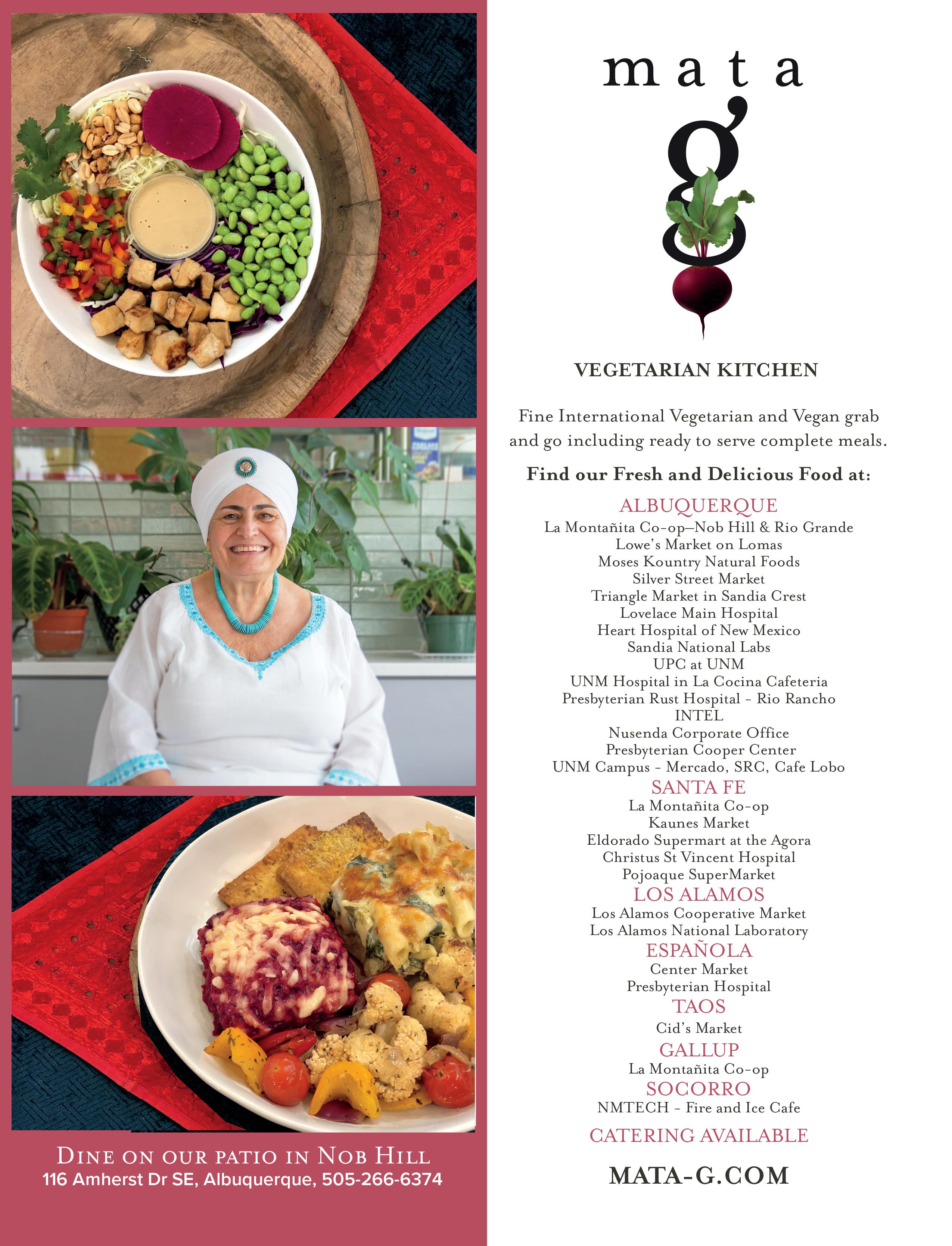


fruit of banana yucca is fleshy and delicious. It makes an excellent pie filling or a naturally sweet side dish, but you’ll have to deal with the yucca moth larvae if they haven’t already left the fruit to pupate underground. If that thought doesn’t make you too queasy to continue, store the ripe fruit in the freezer for a few days. You’ll find the frozen larvae at the bottom of the freezer bag. Feed them to your chickens.
Once you’ve rid your fruit of its larvae, thaw the fruit, then slice it in half and scoop out the seeds. Bake the yucca fruit at 350 degrees Fahrenheit until the flesh is soft, which should take 20 to 30 minutes, depending on how large the fruit are. Scoop out the baked yucca flesh and taste it. You may want to sweeten it just a little if you’re making pie filling, but for a side dish the natural sweetness is perfect. A few caramelized onions on top would take it to the next level.
Yucca flowers bloom from April to June, depending on where you are in New Mexico. They are plentiful and tasty, and any insects inside the flowers can be dislodged easily by rinsing or simply giving the flowers a good shake. Some people experience an itchy throat when eating raw flowers, but cooking alleviates this and also improves the flavor. Yucca flowers should either be used fresh or quickly blanched and frozen for storage. Frozen yucca flowers can be used in egg dishes, sautés, soups, and stews, but will not have the correct texture for stuffing.
YUCCA MOTHS
Almost all yuccas have mutualistic relationships with moths. Flowers open at night, when the moths are active. As the moths pollinate the flowers, they also lay their eggs within the bloom. Both organisms benefit from the relationship: the plants are pollinated and the larvae have a guaranteed food source as they develop. Unfortunately for human foragers, this makes it difficult to find fruit that doesn’t come with a generous side order of protein . . . i.e., yucca moth larvae.
STUFFED YUCCA FLOWERS
This recipe can be reduced or increased proportionately. To separate the petals from the pistils and stamens, grasp them at the base where they join the flower and give a quick twist.
25 rinsed yucca flowers, pistils and stamens removed and reserved
1/4 cup onion, chopped
Olive oil
1/2 teaspoon salt
1/2 teaspoon ground sumac
2 tablespoons green chile, chopped
1/2 cup cream cheese, room temperature
1 egg, beaten
All-purpose flour
Chop the yucca pistils and stamens and the onion into small pieces (approximately 1/4–1/2 inch) and sauté in olive oil until the onions are translucent. Add the salt, sumac powder, and chopped green chile, and stir to combine. Remove from the heat.
Place the cream cheese in a bowl and fold in the warmed ingredients to distribute them evenly.
Fill each yucca flower with a teaspoon of the cream cheese mixture and gently press the flowers closed. Dip each one in the beaten egg, then dredge in the flour and set aside.

Fry the stuffed blossoms in oil until they are a crispy golden brown, and serve warm.

24 edible New Mexico | SPRING 2023

NEW MEXICO STAPLES
GROWING LOCAL AT ES QUE MARKET
 Words and Photos by Ungelbah Dávila-Shivers
Words and Photos by Ungelbah Dávila-Shivers
If you are what you eat, imagine what you could become if your plate were always filled with meals sourced from the community you live in and the lands that surround you. Your veggies would always have tiny carbon footprints, your meats would come from livestock raised on ranches where they are loved and respected, and your atole and posole would come from grains that work with ecosystems rather than against them. You would become an extension of the land you live on. Where and how your foods are produced would matter to you, because they would no longer be “just food”—they would be direct rewards for investing in your neighbors’ livelihoods, in ancient cultures and traditional practices, in land stewardship and sustainability, and in your family’s long-term health and vitality.
Best of all, food would no longer be something associated with fear, whether because of scarcity or because of hidden calories and chemicals. Good food would be valued, children would grow up with bellies full of essential vitamins and minerals fueling their imaginations, and dining tables would once again be the circles at the center of our communities.
Es Que Market, the headquarters for Swan Kitchen (SK), is one such table. Here, located in the heart of downtown Albuquerque, power couple Jessica and David Swan combine their lifelong involvement in regenerative agriculture, community advocacy, and the culinary world for an experience that goes well beyond breakfast burritos (although they do have those too).
26 edible New Mexico | SPRING 2023 BACK OF HOUSE
Pantry essentials at Es Que Market.

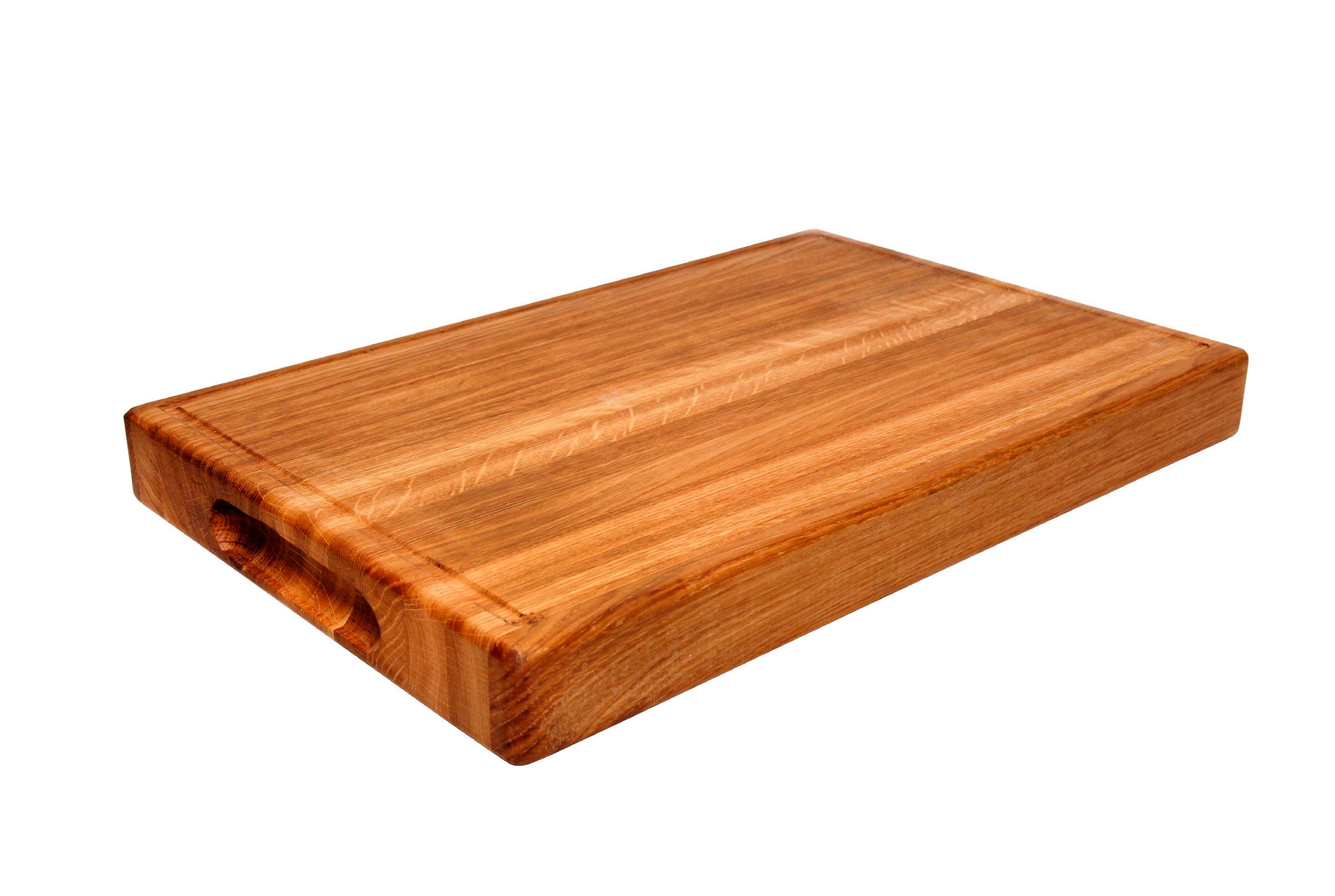










Our Jerky is all-natural, preservative free, and made with only the best local ingredients. local favorites www.vigilsbee erky.com 7625 2nd St NW Building C Albuquerque, NM 87107 (505) 867-3283 Shop all 11 avors! BREAKFAST ‧ LUNCH ‧ CATERING 2933 Monte Vista NE, Albuquerque ‧ 505-433-2795 theshopabq.com @theshopbrealfastandlunch on Instagram and Facebook Open for dine-in, carry out, or delivery. Come in for breakfast or lunch. Creative American classics made from local and organic ingredients. Wednesday–Sunday 8am-3pm
“We have an understanding that food is medicine, and that we can take care of ourselves in the right ways if we’re eating right,” says Jessica, “so we offer a really great farm-to-table breakfast and lunch menu. We’ve been working with Agri-Cultura Network [ACN] since we started our school lunch program in 2014.”

David and Jessica created Swan Kitchen in 2013, preparing food for a local delivery service. But when their oldest child started kindergarten in 2014, the Swans were horrified at the low-quality ingredients being used in school meals. A trained chef who has worked in restaurants since the age of thirteen, David decided to put his skills to work. Swan Kitchen got certified as a food vendor for the school systems, rented space at the South Valley Economic Development Center, and got busy preparing lunches for students using locally sourced food from farms within ACN.

“Why do New Mexicans, people who’ve been here for generations, get commodity food when we’ve been agricultural based for generations?” Jessica asks. “We know how to feed our gente, we just don’t have the resources [due to land loss]. Part of being a New Mexican is really understanding our history, and understanding that we’re all from farming families.”
In the fall of 2021, the three-thousand-square-foot building at the corner of Fifth and Lead became available, and since the Swans had needed to take a step away from the school lunch program during the pandemic, launching a breakfast and lunch spot with hours from 8 to 3, Tuesday through Friday, was a perfect fit for the busy parents. The building is owned by the Guadalupe Institute, a New Mexico nonprofit corporation that, among other initiatives, serves as a depository for La Virgen de Guadalupe memorabilia. The Swans designed the interior of Es Que—a play on SK that roughly translates to “it’s just that”—after the terracotta-orange and turquoise-blue tones of La Virgen’s image that appeared on Juan Diego’s tilma some 450 years ago. In one corner, an altar and collection of Guadalupe art and imagery make up a mini-museum installed by the Guadalupe Institute. Strands of marigolds, dried pomegranates, ristras of the Swans’ chile, and repurposed produce sacks create cozy moments throughout the market and dining area. Mason jars filled with blue cornmeal, posole, apple butter, honey, and other local pantry essentials are for sale alongside local art.
The menu features all-day breakfast staples like burritos, atole (made from Tamaya blue cornmeal), and the Levanta, a sandwich
28 edible New Mexico | SPRING 2023
Left: Marigolds drying. Right: Chef David Swan, co-owner of Es Que Market.
Explore our beautiful space filled with the best wines, spirits, and beers from around the world!
Enjoy a beverage in our Purple Pachyderm in-store lounge.
632 Agua Fria, Santa Fe • free parking in the back 505-984-1582 • SFWineAndSpirits.com

Delivery available from
Dozens of Interesting Wines by the Glass

• Bruschetta Platters to Share
• Great Entrées
Mon & Thurs 5-8pm Closed Tues & Wed 304 Johnson St, Santa Fe 505-989-1166
terracottawinebistro.com

100% natural ingredients from around the world
A collection of artisan made products using natural materials, from cashmere wraps to alpaca throws, Oaxacan pottery, and fine art photography. 1610 Lena Street, Santa Fe | 505. 663. 7784 | LivingThreads.org



upscale Italian cuisine

PRANZO ITALIAN GRILL, 321 JOHNSON STREET, SANTA FE Tues–Sat, 11:30
pm, Happy
BISTRO DINNER Fri
Sun,
PRANZO
am–9
Hour Daily 4–6 pm WINE
& Sat 5-9pm
with scrambled eggs, asadero, and serrano ham. Vegan options, such as La Huerta sandwich (seasonal veggies, pickled onions, and a spicy bean spread) and El Hongo (shredded barbecued mushrooms, vegan slaw), fill the lunch menu alongside meatier offerings like the hearty Chicano (pictured above). Over on the salad side, things stay creative with seasonal veggies and local greens. A blackboard lets customers know exactly where ingredients are coming from, listing producers like Big Bear Farm, Los Jardines Institute, St. Francis Ranch, ACNallied farmers, Vibra Farms, and many more.

“As New Mexican small business owners, we need to stop exporting profits,” says David. “We are already one of the poorest states and we export 97 percent of what we grow. So we’re here to put our foot down and do the best we can not to let that happen in our community by showing, day by day, that keeping profit local can be done.”
On the second Saturday of each month, Es Que hosts Community Supported Dinners that give guests firsthand experience in how locally sourced, regenerative farming can be applied to fine dining. Here guests gather at a long family-style table and feast on seasonal dishes such as platters of roasted root vegetables and plates of juniper-roasted trout on
blue corn grits, and sate their sweet tooth with a bit of toasted pistachio ice cream or chocolate lava cake.
“I’ve got twenty years of fine dining experience and so that has manifested into these Community Supported Dinners,” says David. “It’s kind of a play on community supported agriculture. And so we’re using local products to bring the community together.”
Meanwhile, the Swans are still involved with youth engagement and education. They sponsor cooking classes through ACN’s Cooking for Health program and do farm-to-table meals at the Gutiérrez Hubbell House, where they introduce families to some of their values and practices.
“The articles I’ve been reading say that when you buy from local farms you reduce your shrinkage [food waste] by at least 50 percent,” says Jessica. “We believe in being totally sustainable and regenerative farmers by using the ancestral agricultural knowledge that was passed down to us. Monsanto didn’t teach us. Our elders taught us how to farm, so it’s not, you know, greenwashing, it’s just traditional food the way it’s always been.”
30 edible New Mexico | SPRING 2023
319 Fifth Street SW, Albuquerque, 505-243-6563, es-que-market.square.site
The Chicano, Chef Swan’s take on the cubano, with carnitas, serrano ham, red chile aioli, pickled green chile, and asadero and manchego.



Best
BEING THERE —An extraordinary SHOP— FIRST FRIDAY FRIDAY, APRIL 7, 5-8 PM FEATURING MURAL ARTIST DENISE WEAVER ROSS’ POSTCARDS TO AMERICA OPEN: WEDS-SUN: 12–4PM, 1315 MOUNTAIN RD NW, ABQ WWW.BEINGTHEREABQ.COM EARTH DAY APRIL 22, 10 AM –3:30 PM ARTS & CRAFTS POP-UP WITH FOOD & MUSIC
The Next
Thing TO
FOUR-SEASON FARMING AND DINING NORTH OF SANTA FE

 By Candolin Cook
By Candolin Cook
In northern New Mexico, when we think of the growing season, we think of spring: tender turnip shoots poking through freshly thawed soil, pea blossom tendrils wrapped around a trellis. We also think of summer, with its bounty of juicy heirloom tomatoes and technicolor peppers. And, of course, we think of fall. Rainbow corn, pumpkin patches, and the iconic autumnal harvest cascading out of a cornucopia basket. But what of winter? It is true that farming in cold weather can be unforgiving—frostbitten crops, impenetrable dirt, freezing hands. Yet growing certain vegetables in the winter offers its own appetizing advantages.
Consider the spinach leaf (as David Foster Wallace might prompt). When spinach and other hearty leafy greens grow in cold weather, they convert some of their starch stores into sugar, which keeps the water in their cells from freezing. In addition, because of the wide temperature swings we experience in New Mexico, our spinach leaves might frost and thaw several times, repeatedly triggering the release of “antifreeze proteins” (polypeptides that modify the growth of ice crystals and reduce the freezing point of water). These processes are said to alter and improve the flavor of many winter crops. Thus, that which makes the plant stronger also makes it sweeter.
32 edible New Mexico | SPRING 2023
FACES OF FOOD
Left: Sunchokes and squash from The Vagabond Farmers and mushrooms from Full Circle Mushrooms. Right: Maitake mushroom rillette with pickled Hinona Kabu turnips. Photos by Stephanie Cameron.





730
St Michaels Dr, Santa Fe, loyalhoundpub.com
On the coldest day of last December, I visited The Vagabond Farmers, a four-season, one-acre farm located in La Puebla, to take a peek at their winter vegetable production. Tucked under cover cloth inside a sixteen-foot-tall unheated high tunnel, The Vagabond Farmers’ Auroch spinach crop was in full production. “I wouldn’t eat spinach outside of winter,” professes farmer and co-owner Astrid Yankosky. “This variety stands upright and has [sturdy] leaves, but I think the taste really comes from the weather.”

Yankosky and partner Osiris Nasnan are no strangers to farming in icy conditions. The two moved from Minnesota three years ago, where Nasnan’s family have been potato farmers for generations. Yankosky studied agriculture at The Evergreen State College in Washington, and previously worked with a refugee resettlement agency cultivating a community garden. As recent transplants to New Mexico, the farmers say they wanted to carve out a niche for themselves in the local market (and avoid stepping on any toes) by largely concentrating on speciality or harder-to-find crops, such as baby carrots, Japanese cucumbers, cut greens, and Principe Borghese tomatoes, which are ideal for sun drying. In addition to selling at the Santa Fe Farmers’ Market, they work with a handful of local chefs, including Allison Jenkins of Arroyo Vino and Graham
Dodds, who, fifteen miles up the road at NOSA Restaurant and Inn, was prepping their vegetables as we spoke.
Like winter, NOSA has a quiet serenity to it. The Ojo Caliente property sits at the end of a secluded gravel road, surrounded by the Jemez Mountains. Along with four impeccably decorated guest suites, it boasts a grand, Santa Fe–style main lodge with three elegant dining spaces of varying size and purpose. As the sole chef and innkeeper on duty, Dodds preps, cooks, plates, and, often, checks guests in, all while tending to a simmering beef stock. “It’s nice not to have anybody dictate what I’m doing. Sometimes (well meaning) owners will have ridiculous ideas or want what’s trendy, but that doesn’t fit into my vision.” At present, the chef’s vision includes an ever-changing, multicourse prix fixe menu served for breakfast (daily), lunch (Sundays), and dinner (Saturday–Sunday).
Like The Vagabond Farmers, Dodds is new to the state. He opened NOSA (an acronym-of-sorts for “NOrth of SAnta Fe”) only last July, after he saw that the former Rancho de San Juan property was for sale and went to work finding investors to make his longtime dream

34 edible New Mexico | SPRING 2023
Left: Osiris Nasnan and partner Astrid Yankosky of The Vagabond Farmers, photo by Candolin Cook.
Right: Graham Dodds of NOSA, photo by Stephanie Cameron.
FIND OUR COCKTAILS AT A LOCATION NEAR YOU OR ORDER ONLINE AT MIXEDUPCOCKTAIL.COM


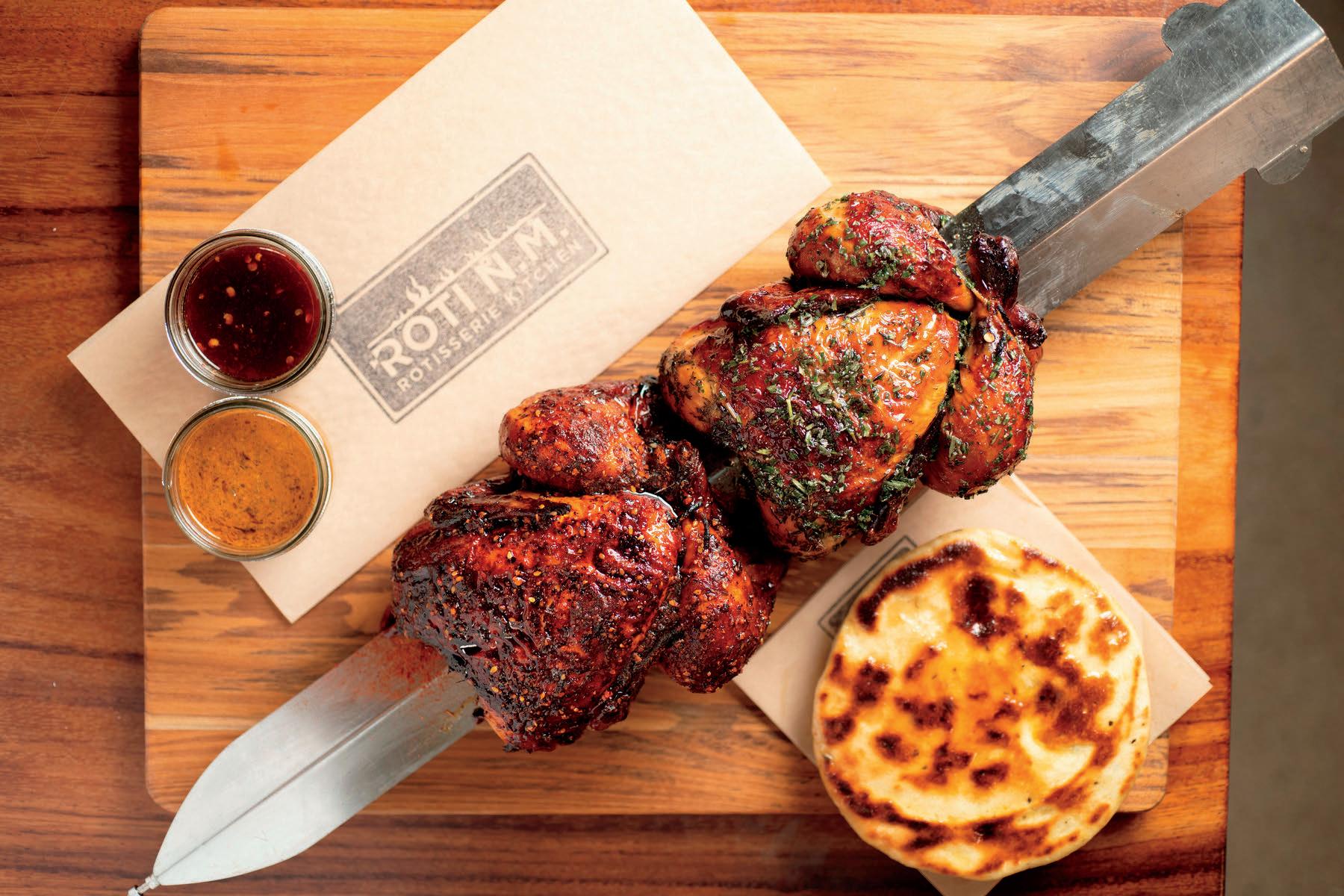
Any bartender worth his or her salt knows that the ingredients make the cocktail. And that’s where Mixed-Up Mule® cocktails start—with fresh, all-natural flavors like grapefruit, watermelon, mint and even jalapeños. Then we add our quality spirits to craft a unique twist on classic cocktails you can take wherever you go!
AVAILABLE IN WHOLE FOODS MARKET, ALBERTSONS, KELLY LIQUORS, AND OTHER LIQUOR STORES THROUGHOUT NEW MEXICO AND EL PASO.



200
BY
LITTLE TOAD CREEK DISTILLERY IN SILVER CITY, NEW MEXICO. NEVER ANY ARTIFICIAL FLAVORS, COLORS, ADDITIVES, PRESERVATIVES OR STABILIZERS.
N
BULLARD ST. SILVER CITY • 119 N MAIN ST. LAS CRUCES LITTLETOADCREEK.COM
flybyprovisions.com At Flyby Provisions, we embrace our relationships with talented artisans, sustainable producers, and values-driven small businesses. We make it easy for you to deliver thoughtful, feel-good gifts to the people you love! visit our flagship store at 201 Coal SW, ABQ just a few doors down from Zendo Coffee and Sidetrack Brewing Experience Chef-Driven, Scratch-Made Rotisserie Comfort Food at Sawmill Market Savory Rotisserie Chicken, Salads, Naan, Sides and Sauces Sawmill Market | 1909 Bellamah Avenue | Albuquerque, NM 87104 (505) 814-3653 | rotinm com
of living in New Mexico come true. In his hometown of Dallas, Texas, where temperatures rarely hit freezing, Dodds is known as a trailblazer in the local farm-to-table dining scene and a champion of sourcing locally and sustainably. “I love cooking that way. People should be eating what’s around. I like to base my [dishes] around an epic ingredient and go from there. That’s the fun part.”


Sourcing locally doesn’t come quite as easily in the remote Ojo Caliente River Valley. In addition to Tuesday trips to the Santa Fe Farmers’ Market, Dodds feels lucky to have forged relationships with nearby Ojo Farm and The Vagabond Farmers. “I don’t think I’ve ever had nicer spinach before,” Dodds says of Vagabond. “It has these great leaves that are sweet and don’t turn to mush when you cook them.”
On this chilly December night, NOSA’s cozy dining room is warmed by a crackling fire and adorned with a tastefully decorated Christmas tree. Much like the space, the evening’s five-course meal manages to feel both rustic and elevated. It begins with a simply plated assortment of lamb rillette, chokecherry jam, Bread Shop cherry poppy toast, and a pickled Vagabond Farmers Hinona Kabu turnip. This is followed by a soup course, in which red kuri kabocha is transformed into liquid velvet. I don’t know how much cream and/or
butter is in this dish (hint: must be a lot) but it is unequivocally the best squash soup I’ve ever had. Next comes a picture-worthy tribute to Olmsted’s (of Brooklyn) buttery carrot “crepe,” featuring Vagabond Farmers’ turnips, watermelon radish, and carrots, cut paper thin. The penultimate course is a Lazy BG Farm rib eye steak (hallelujah to grassfed beef that is this succulent), paired with Ximena Zamacona’s (of Full Circle Mushrooms) chestnut mushrooms and the spinach I’ve been hearing so much about. Prepared in a garlic confit with roasted red onion, it is indeed sweet, hearty, and making a case that spinach should only be consumed in the wintertime. The meal caps off with a golden tarte tatin. Still bubbling from the oven and topped with La Lecheria’s pistachio ice cream, the caramelized apple dessert is— excuse the obnoxious food-writer word—transcendent.
“I think [NOSA] is filling a void in the [fine dining] food scene of this area,” Yankosky later tells me. It seems that both Dodds and The Vagabond Farmers are finding their niche. As we transition into spring, I look forward to seeing how the season will shape the food they grow and cook—and that might just mean it’s time for another trip north of Santa Fe.
36 edible New Mexico | SPRING 2023
49 Rancho de San Juan, Ojo Caliente 505-753-0881, nosanm.com
Left: Sunchoke soup. Right: Roasted squash. Photos by Stephanie Cameron.








ASK ABOUT OUR TOURS 8114 Edith NE, Albuquerque 505-433-4076 eldorachocolate.com WEDNESDAY–SUNDAY, 5–9PM 3120 Central Ave SE, Albuquerque mesaprovisions.com MESA PROVISIONS Reservations required 505.494.5264





38 edible New Mexico | SPRING 2023 visit the new concepts at New Mexico’s premier Food Hall Sun-ThU 8am-9pm Fri-Sat 8am-10pm | 1909 bellamah ave. NW, Albuquerque SaWmillmarket.com
Little Madrid
Flora Restaurant
West Cocktail & Wine Bar
Mercantile Cafe
39 EDIBLENM.COM INSIDE SAWMILL MARKET Daily 11am-9pm | 1909 Bellamah Ave. NW, Albuquerque SawmillMarket.com

COOKING FRESH
The Raw and The Cooked
Words and Photos by Stephanie Cameron
To cook, or not to cook? With vegetables, that is always the first question. Eating raw vegetables provides your body with folate, fiber, and water-soluble vitamins such as vitamin C, yet the nutrients in some cooked vegetables are easier to digest and absorb. Cooking vegetables leads to the release of vitamins E and K, along with better mineral absorption. Some vegetables are high in certain vitamins, whether raw or cooked. For example, tomatoes, a common dietary source of the antioxidant lycopene, are even higher in lycopene when cooked because the heat breaks through the skin to release more of this nutrient. In their raw form, tomatoes are a great source of vitamin C.
Cook time, oils, and technique can impact a vegetable’s nutritional value. Unless they’re deep fried, quickly cooked vegetables tend to retain more of their nutrients. Olive and avocado oils contain phenols, which are antioxidants, and some studies show that cooking vegetables in extra virgin olive oil increases the diversity of nutrients while helping the body absorb them. Cruciferous vegetables, such as cauliflower, kale, bok choy, and radishes, cooked in olive oil also maintain higher levels of certain vitamins and antioxidants than when they’re boiled. The skins, in addition to having their own
vitamins and minerals, protect the vegetable’s nutrients during the cooking process—so if you cook a vegetable with edible skin, don’t peel it, just wash it thoroughly.
And while we are on the subject of nutrition, University of California, Davis, studies show that vegetables can lose 15 to 77 percent of vitamin C and 30 percent of other nutrients within a week of harvest. Almost all the veggies you get at the grocery store spend five days in transit before arriving at a distribution center and another three days on a store shelf before they are purchased by the consumer, who may store them for up to seven days before consumption—all the more reason to buy your produce locally and in season from farmers markets and CSAs.
In this edition of Cooking Fresh, we celebrate the versatility of some local veggies coming to market this spring. We can’t say which preparation is the healthiest, or whether veggies in general are more nutritious raw or cooked. What we can say with certainty is that these flavor-packed recipes will ensure that you eat your recommended three to five servings of veggies a day, and sometimes all in one dish made for four people because you will want to consume it all yourself. Hello, big salad!
THE RAW
CRUDITÉS (on the cover)
Building a beautiful crudités platter is easier than you might think and makes a spectacular centerpiece with its beautiful colors and textures. Pair your crisp veggies with dips and sauces that reflect the season. You can find everything you need to make a vegetable platter at the grocery store, but if you want to step it up a notch, plan a trip to your local farmers market—you will see and taste the difference.
Pro tip: Refresh vegetables in ice water. Sometimes even fresh vegetables become stale and limp as they sit in the refrigerator. To fix this, fill a large bowl or your kitchen sink with ice water. Drop the vegetables into the ice water, let them sit for 1–2 minutes, then remove and dry them on a clean kitchen towel. The ice water will instantly crisp up and rehydrate almost any vegetable, especially carrots, cucumbers, lettuce, and radishes.
If preparing your platter ahead of time, keep your vegetables fresh by covering them with damp paper towels and storing them in the refrigerator. The wet towels will keep the veggies hydrated!
SPICY FETA DIP
Makes 1 1/4 cups
Level: Easy | Prep Time: 15 minutes
The salty tartness of whipped feta combined with jalapeño makes this a perfect match for a crudités platter.
1/2 cup parsley leaves and stems, roughly chopped
1 tablespoon lemon juice
1/2 tablespoon lemon zest
1/4 cup olive oil
1 clove garlic
1 jalapeño, stems and seeds removed
8 ounces feta cheese
1/4 cup cream cheese, at room temperature
Salt and freshly cracked black pepper
Place parsley, lemon juice and zest, olive oil, garlic, and jalapeño in the base of a food processor. Pulse ingredients together until smooth. Season with salt and pepper, pour mixture into a bowl, and set aside. Add cream cheese and feta cheese to the food processor. Pulse until smooth and creamy. Spread whipped feta into a shallow bowl and top with parsley-garlic-jalapeño mixture.
41 EDIBLENM.COM
RADISH TERRINE WITH CHILE CRISP (OR BALSAMIC)

Serves 8
Level: Easy | Prep time: 10 minutes;
Total time: 6 hours
This recipe is worth the investment in a set of silicone mini loaf pans—which you can use later to experiment with compound butters or make mini loaves of zucchini bread. If you want a little spice, opt for the chile crisp version; for a concentrated sweet flavor, use balsamic. Please, use only high-quality balsamic from Modena or Monticello.
6–8 small, round radishes, about 1/2 inch 1 1/2 cups unsalted butter (preferably European), diced and softened 1 tablespoon chile crisp or balsamic vinegar
Slices of fresh bread
Fleur de sel
Remove taproots and leafy tops from the radishes, forming perfectly round spheres. (If in good condition, reserve the leaves for another use / to add to your braising greens.) Wash and thoroughly dry. In a large bowl, fold softened butter and chile crisp (or balsamic vinegar) with radishes using a rubber spatula. (Alternatively, use a hand mixer to whip chile crisp with butter, then fold in radishes.) Transfer radish butter to loaf pan and spread it to the edges; smooth the top and try to remove any air bubbles. (Alternatively, transfer butter to a sheet of parchment paper and roll it into a log.) Refrigerate the terrine until very firm, 4–6 hours.
Push the terrine out of the silicone mold (or remove the parchment wrap) and transfer it to a work surface. Using a very sharp knife or gently serrated bread knife, cut the terrine into 1/4-inch-thick slices.
Serve with slices of fresh baguette and finish with fleur de sel.
CULTURE IS OUR KEY INGREDIENT.
Have you ever had a dish transport you in time? Or take a bite so decadent you lose yourself, even for just a moment? In Santa Fe, every dining option offers a unique experience unlike any other. From honey-soaked sopapillas to the subtle heat of chiles, Santa Fe fills each plate with bold, unforgettable flavor. There are so many things that make The City Different, and so much more waiting to be uncovered.
UNCOVER YOUR DIFFERENT AT SANTAFE.ORG

43 EDIBLENM.COM
WATERMELON RADISH SLAW

Makes 3 cups
Level: Easy | Prep time: 15 minutes
This versatile, bright, and tangy slaw can be served as a side, added to a salad or sandwiches, or used to top your favorite seafood dish or tacos.
4 large watermelon radishes (1 pound), washed but not peeled, tops and bottoms cut off
Dressing
1/4 cup orange juice, freshly squeezed
3 tablespoons apple cider vinegar
2 tablespoons fresh tarragon leaves (1 1/2 teaspoons if using dried)
2 tablespoons Dijon mustard
1 tablespoon honey
1 tablespoon fresh ginger, grated
Zest of 1 orange
1/4 cup olive oil
Combine all ingredients for the dressing and whisk together thoroughly. Cover and chill for an hour so the flavors can meld together. Julienne the watermelon radish on a mandolin (use the small teeth). Once the dressing is chilled, toss radish with dressing; serve immediately.





Fresh Italian Kitchen 505.780.5279 • RusticaSantaFe.com 2574 Camino Entrada, Santa Fe Across from our sister restaurant: The Ranch House Cheers!
THE COOKED
Grilling, roasting, and panfrying vegetables are all options when you are longing for caramelized flavors and want to use heat to bring out the piquancy of your veggies. The time, equipment on hand, and type of meal you’re cooking will determine which technique you should use. However, don’t feel afraid to experiment with all three. If you always grill, give yourself a break by roasting veggies on a sheet pan instead. And if you don’t have a grill but are interested in grilling produce, consider investing in a grill pan that works on the stovetop.
GRILLED KALE WITH SPICY AVOCADO DRESSING
Serves 4
Level: Intermediate | Prep time: 15 minutes; Cook time: 5 minutes; Total time: 20 minutes
Charred kale leaves change up the usual lettuce plan for salads. Radicchio, romaine, and swiss chard are also good contenders for the grill.
1 bunch green kale (curly or dino)
2 tablespoons olive oil
Salt and pepper for seasoning
Dressing
1/4 cup raw cashews, soaked for at least 4 hours
1/2 cup cilantro
2 garlic cloves
1 1/2 tablespoons jalapeño, diced
1 avocado
3 tablespoons lime juice
3/4 cup water
1/4 teaspoon salt
Add all the dressing ingredients to a small blender or food processor and pulse until smooth, adding more water as needed, 1 tablespoon at a time. Cover and chill for an hour so the flavors can meld together.
Preheat grill to the highest setting. Drizzle kale with a tablespoon of olive oil and massage it into the leaves. Sprinkle with salt and pepper. Place kale pieces in a single layer on the grill and cook for 1–2 minutes, until charred, then flip over and cook for an additional minute.
Remove kale from the grill, tear the leaves from the stems, and toss them with the avocado dressing. Add in chickpeas, croutons, or any fresh veggies on hand.









GROW Y’OWN Be your own farmer WWW.RAISEDBED.BIZ • 505.490.1849 GROW YEAR-ROUND WITH HOOPED RAISED BEDS AND SEASONAL COVERS NEW THIS SPRING!!! MED BEDS AND SETUPS WHY PHARM, WHEN YOU CAN FARM?! 505.898.3562 AlamedaGreenhouseABQ.com 9515 4th St NW n Albuquerque, NM 87114
BOK CHOY WITH MISO GINGER DRESSING

Serves 4
Level: Easy | Prep time: 10 minutes; Cook time: 5 minutes; Total time: 15 minutes
A well-stocked pantry ensures you can pull together this simple vegetable dish on short notice. Varying the seasonings, sauces, and oils can change the meal completely, using the same technique, or swap in additional or different vegetables such as asparagus or carrots, adjusting cook time as needed. Don’t be afraid to experiment.
1 1/2 pounds baby bok choy, split lengthwise
1 tablespoon avocado oil
1 tablespoon ginger garlic paste
Salt to taste
Dressing
2 tablespoons toasted sesame oil
2 tablespoons rice vinegar
1 tablespoon white miso
1 tablespoon orange juice
1 tablespoon avocado oil
1 tablespoon Greek yogurt (optional)
1 teaspoon ginger garlic paste
Toasted sesame seeds, for garnish
In a medium bowl, combine all dressing ingredients and whisk until smooth and emulsified.
Add oil and ginger garlic paste to a wide skillet. Place over medium heat and cook, stirring occasionally, until the oil begins to bubble around the ginger garlic, but before it starts to brown.
Toss in the bok choy and spread into one layer, cut side down. Sprinkle with salt, then cook, without stirring, until starting to turn brown, about 2 minutes. Flip and cook for another 2 minutes or until the green leaves have wilted and the white bottoms have begun to soften but still have some crunch.
Drizzle bok choy with dressing. Garnish with toasted sesame seeds and browned ginger garlic bits from the pan, if desired.
48 edible New Mexico | SPRING 2023


Your grass. Our gas. Brought to you by your amigos at TheHerbTaxi.com
HAKUREI TURNIPS WITH SPICY BONITO LEMON DRESSING

4 servings
Level: Easy | Prep time: 10 minutes; Cook time: 30 minutes; Total time: 40 minutes
Hakurei turnips taste sweet, like many crops harvested young and in cool or cold weather. These turnips are so mild that they hardly taste like turnips and are so tender and crisp that they can be eaten raw and served in salads, but they are also delightful when roasted.
1 cup bonito flakes
1/4 cup sugar
1/4 cup usukuchi (light) soy sauce
1/4 cup mirin (sweet Japanese rice wine)
1/2 tablespoon ichimi togarashi
Zest (about 1/2 tablespoon) and juice of lemons (about 1/4 cup juice)
2 bunches Hakurei turnips, with tops
2 tablespoons vegetable oil
Kosher salt
Toasted sesame seeds (for serving)
Preheat oven to 425°F. Grind bonito flakes in a spice mill or blender until finely ground (should equal about 1 tablespoon). In a medium saucepan, bring ground bonito, sugar, soy sauce, mirin, and togarashi to a boil. Reduce heat to medium and simmer, stirring often, until reduced by a third, 12–15 minutes. Pour dressing into a small bowl; cover and chill until cold, at least 30 minutes and up to 3 days. Stir in lemon zest and juice when ready to serve.
Meanwhile, separate the tops from the turnips. Trim stems from leaves; discard. Coarsely chop leaves. Cut turnips into 1-inch wedges. Toss turnips and leaves with oil on a rimmed baking sheet; season lightly with salt (the dressing is salty). Roast, tossing halfway through, until leaves wilt and turnips turn golden, about 12–15 minutes. Transfer turnips and leaves to a platter; spoon some of the dressing over (save the extra). Sprinkle with sesame seeds.
50 edible New Mexico | SPRING 2023
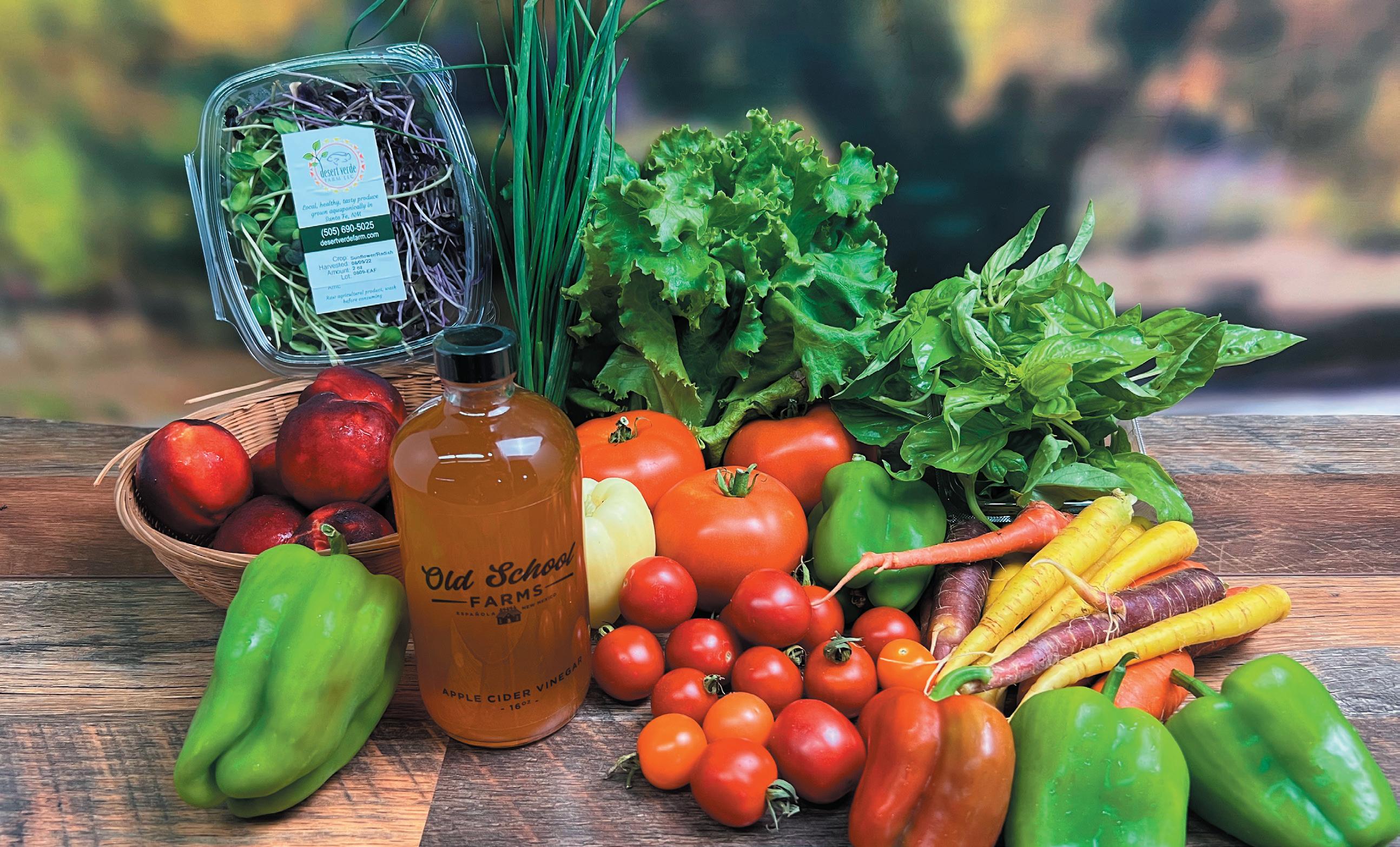



Community Supported Agriculture
Community supported agriculture (CSA), or farm shares, is one way consumers can directly support local farmers and invest in the local food system. CSAs have different financial structures—with some, you pay up front to help growers buy seeds, animals, supplies, or equipment for the season; with others, you pay as you go. Either way, your community money goes directly to the farm, helps build a steady revenue base for the growing season, and secures your supply of local produce. Not only confined to vegetables and herbs, some CSAs include the option for shareholders to buy eggs, homemade bread, meat, cheese, fruit, flowers, or other farm products. Maybe year-round!
ADVANTAGES FOR CONSUMERS:
• Eat ultra-fresh food with tons of flavor and nutritional benefits
• Get exposed to new vegetables and new ways of cooking
• Take the opportunity to visit the farm your food is coming from
• Develop a relationship with the farmer who grows your food and learn more about how food is grown
This list is not exhaustive, but it will give you a place to start finding an option that might work for you.
ALBUQUERQUE AND SURROUNDING AREA CSAs
Better Together CSA Albuquerque
Distribution: Barelas Community Coalition office at the Hispano Chamber of Commerce
Share season: May–Oct; orders start in Mar bettertogethercsa.bigcartel.com
Chispas Farm South Valley
Distribution: Pickup at farm
Share season: Jun–Oct; orders start in late Feb chispasfarm.com
Indigenous Farm Hub Corrales
Distribution: Pickup at farm and in Old Town Albuquerque
Share season: May–Oct; orders start in Feb indigenousfarmhub.org
La Cosecha CSA South Valley
Distribution: Pickup at South Valley Economic Development Center and Central United Methodist Church
Share season: Jun–Oct; orders begin in May agri-cultura.org/la-cosecha-csa
Loose Leaf Farm Los Ranchos de Albuquerque
Distribution: Pickup at farm
Share season: May–Oct; orders start in Feb instagram.com/looseleaffarm
Matt’s Mushroom Farm Los Ranchos de Albuquerque
Distribution: Pick up at Casa Barelas
Share season: Fresh mushrooms every week, year-round mattsmushroomfarm.com/mushroom-csa
Rail Yards Market Veggie Box Albuquerque
Distribution: Pickup at the Rail Yards Market in Barelas; save 10% when prepaying for the season
Share season: May–Oct railyardsmarket.org
Schwebach Farm Moriarty
Distribution: Pickup in Edgewood, Cedar Crest, Albuquerque, and at Schwebach farm market in Moriarty
Share season: Jul–Nov; sign-up at end of Feb schwebachfarm.com
SANTA FE AREA CSAs
Green Tractor Farm La Cienega
Distribution: Pickup locations in La Cienega and Santa Fe Share season: May–Sept; sign-up at beginning of the year greentractorfarm.com
Monte Vista Organic Farm La Mesilla and Taos
Distribution: Pickup locations in Los Alamos, Española, and Santa Fe Share season: Jun–Oct montevistaorganicfarm.com
Santa Fe Farmers’ Market Ag Bag Santa Fe
Distribution: Pickup at Santa Fe Farmers’ Market Pavilion
Share season: Year-round, with thirteen-week subscriptions santafefarmersmarket.com
NORTHERN NEW MEXICO CSAs
Diamond Sow Garden Llano
Distribution: Local pickups and at the farm
Share season: May–Oct; sign-up in May diamondsowgarden.com
Khalsa Family Farms Española
Distribution: Los Alamos Farmers Market and at farm stand
Share season: Year-round, with ten-week shares available at any time khalsafamilyfarms.com
Querencia Farm Colfax County
Distribution: Pickup at the farm and Trinidad Community Farmers Market
Share season: May–Oct instagram.com/querenciafarmnm
Taos Community Farm Taos
Distribution: Pickup at Farmhouse Bakery & Cafe
Share Season: May–Oct, orders start in late Feb airetaos.org
SOUTHERN NEW MEXICO CSAs
Desert Micro Las Cruces
Distribution: Home delivery in Doña Ana County
Share season: Year-round, with twelve-week shares desertmicro.life
Farm Fresh Mobile Market, La Semilla Food Center Anthony
Distribution: Pickup at La Semilla Food Center
Share season: Year-round lasemillafarmfresh.com

Taylor Hood Farms La Union
Distribution: Home delivery in Las Cruces and El Paso areas
Share season: Year-round, with twelve-week shares and flexible deliveries taylorhoodfarms.com
ON OUR COUNTER
Art, Culture, History and Beyond

To learn more contact Cara O’Brien, Director of The Circles, at 505.216.0848 or email cara@museumfoundation.org or visit museumfoundation.org/the-circles.

53 EDIBLENM.COM
adventure: Iceland, October 29–November 4, 2023 Experience the history, traditional cuisine and natural wonders of Iceland. Join The Circles Explorers, the Museum of New Mexico Foundation’s newest membership program, tailor-made for those with an adventurous spirit. We’re pioneering a new way to engage in the art, culture and history of New Mexico—and the world—beyond the walls of our four state museums in
and
Next
Santa Fe
eight historic sites statewide.
Other Sources for Local Veggies
If you aren’t ready to commit to a CSA, below are other services and businesses that give you access to local food in addition to all the fantastic farmers markets out there. The New Mexico Farmers’ Marketing Association lists all the farmers markets in the state at farmersmarketsnm.org
YEAR-ROUND SUBSCRIPTION SERVICES
New Mexico Harvest Albuquerque and Santa Fe
Distribution: Home delivery of weekly shares and à la carte orders around Albuquerque and Santa Fe, surrounding areas, and designated pickup locations newmexicoharvest.com
Squash Blossom Local Food Santa Fe
Distribution: Six pickup spots in and around Santa Fe, farm stand in Nambé, and home delivery squashblossomlocalfood.com
FARM STANDS AND ONLINE OPTIONS
Bluefly Farms Albuquerque
Preorder plant starts and pick up at farm shop starting in Apr. Herbs, body products, and Bluefly Farms’ Sparkling Waters are also available year-round at the shop.
2506 Washington NE, Albuquerque, blueflyfarms.com
Bomvida Farms Bosque
Retail store is open to the public and memberships for local farm groceries are offered for one flat fee.
23 Winery Rd, Bosque, bomvida.com
EMS Farms Albuquerque
Order flowers and produce online; pick up at farm shop.
2506 Washington NE, Albuquerque, emsfarmsproducts.square.site
FARMesilla Mesilla
Quality seasonal produce from regionally located family farms. Breakfast and lunch served daily.
1840 Avenida de Mesilla, Mesilla, farmesilla.com
Polk’s Folly Butcher Shop and Farm Stand Cedar Crest
Polk’s Folly is a small, family-run local food shop offering humanely raised meats, fresh eggs, pesticide-free vegetables, and a variety of other goods made with locally sourced ingredients.
12128 N Hwy 14, Cedar Crest, polksfolly.com
Reunity Resources Farm Santa Fe
The farm stand sells produce grown at the farm along with other local products, and farmers and home growers can purchase compost at the soil yard.
1829 San Ysidro Crossing, Santa Fe, reunityresources.com
Simple Revolution? Farm! South Valley Albuquerque
Keeping it simple, regenerative, and sustainable. Home of the proud honor system farm stand.
4329 Isleta SW, Albuquerque, instagram.com/simplerevolutionfarm
The Farm Stand Corrales
The Farm Stand sells Silver Leaf Farms produce, Milagro Wine, small-batchroasted coffee, Hartford Square baked goods, and other value-added products. 4206 Corrales Rd, Corrales, milagrofarmstand.com
The Fruit Basket Velarde
Find fresh, organic fruits and vegetables, chile ristras, and more, Jun–Oct. 1413 Hwy 68, Velarde, facebook.com/Velarde.Orchards
Whole Heart Farm South Valley Albuquerque
Subscribe to their weekly email newsletter for details on purchasing vegetables year-round.

wholeheart.farm
If you are a farm with a CSA or a farm stand in New Mexico and would like to be part of this resource on edible New Mexico’s website, please contact us at info@ediblenm.com. Readers can find this local farm guide at ediblenm.com/guides
COUNTER
ON OUR










Payne’s Organic Soil Yard 6037 Agua Fria 505-424-0336 Payne’s South 715 St. Michael’s 505-988-9626 Payne’s North 304 Camino Alire 505-988-8011 Happy Gardening! paynes.com Stop by Today and Start Growing Your Own Fresh and Healthy Produce! Payne’s Nurseries have been growing hardy heirloom vegetables & herbs in Santa Fe for more than 71 years! Choose from our homegrown starter plants or from our large selection of 2023 seeds available now. Check out our extensive selection of fruit trees on our website at paynes.com
EDIBLE INGREDIENT

Mushrooms
SPONSORED BY
Photo by Stephanie Cameron
MUSHROOM RAGU
Recipe adapted from Giada De Laurentiis
Serves 4


1/4 cup olive oil

1 large yellow onion, chopped
2 garlic cloves, minced
1 pound mixed Full Circle Mushrooms (black pearl king, oyster, shiitake), chopped*
1/2 teaspoon salt
1/4 teaspoon black pepper

























1/2 cup Marsala wine (or sweet vermouth)
2 1/2 cups vegetable broth
1/2 cup half-and-half


Handful fresh basil leaves, chopped
1/4 cup flat-leaf Italian parsley, chopped
3/4 cup grated Parmesan
Level: Intermediate | Prep time: 10 min; Cook time: 45 min; Total time: 55 min

In a large skillet, heat oil over high heat. Add onions and then lower heat to medium low and cook until the onions are translucent, about 8 minutes. Add garlic and cook for 1 minute longer. Add mushrooms, season with salt and pepper, and raise heat to high. Sauté until mushrooms are tender and all the liquid has evaporated. Pour in Marsala and deglaze the pan; lower heat to medium low and allow the wine to evaporate, about 3 minutes. Add broth and simmer for 30 minutes, until the sauce has reduced by half. Add half-and-half and mix well. Remove pan from heat and add fresh herbs and Parmesan. Mix thoroughly.
Serve with polenta, rice, or pasta.
*Sourcing note: La Montañita Co-op carries several varieties of Full Circle Mushrooms in their produce section.







57 EDIBLENM.COM
PORTRAIT OF A FARM
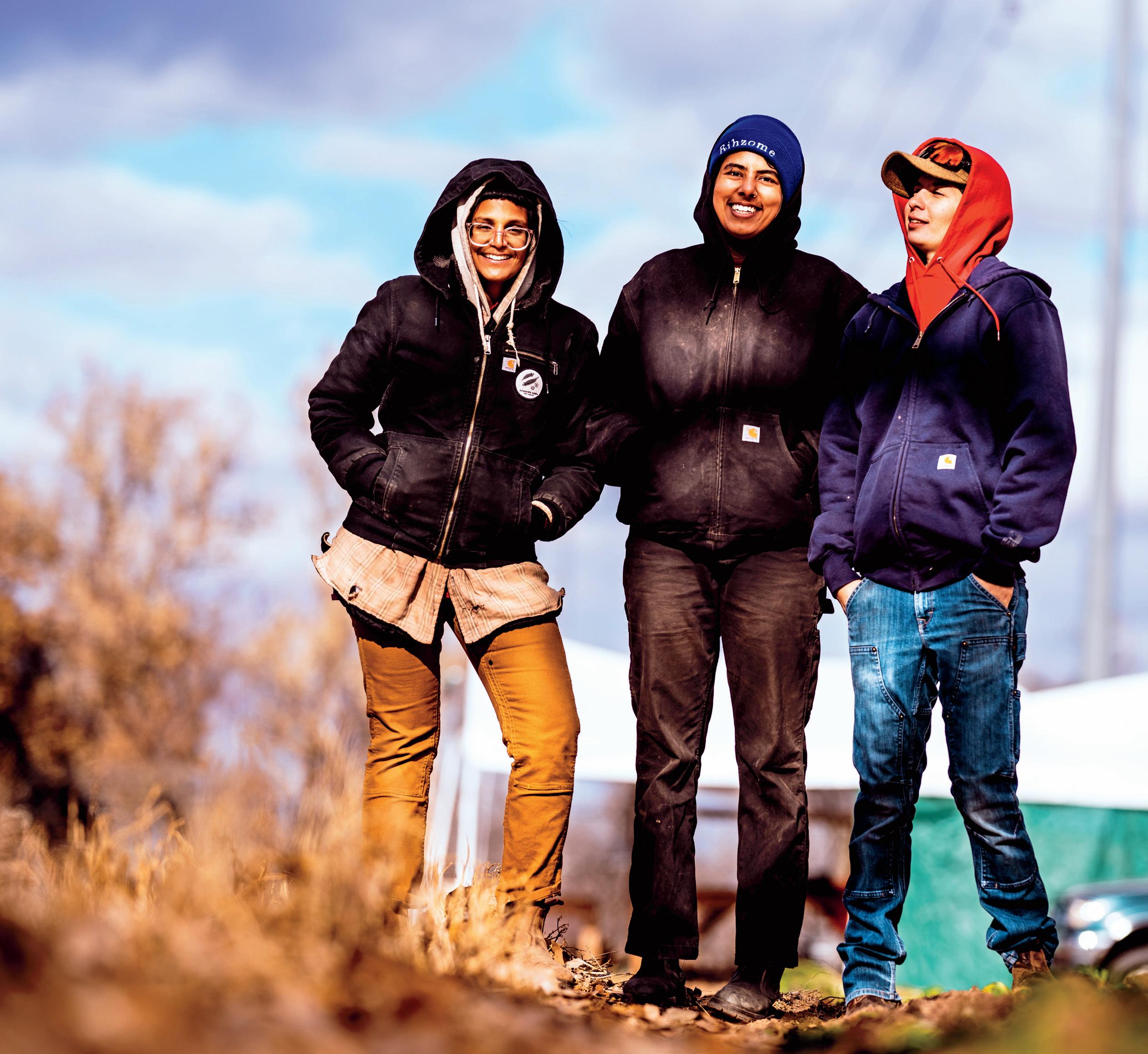
58 edible New Mexico | SPRING 2023
Interview by Briana Olson · Photos by Nathaniel Tetsuro Paolinelli
Ashokra Farm is named for Anita Adalja’s father, whose name is Ashok, and for okra, a mainstay of Indian cuisine and the farm’s first crop. Ashokra operates on two and a half leased acres split between four fields in Albuquerque’s North Valley. Although the farm is currently co-owned by Anita and Ash, the farmers have a dream of collective ownership, a model integrating shared responsibility, shared management, and shared profits.
PEOPLE
Anita Ashok Adalja (left): I was practicing as a social worker in Crown Heights, Brooklyn, and I started a rooftop garden with a coworker. It changed my way of thinking and what I wanted to do with my life.
Seasons farming: 12
Side hustles: Food safety trainings for farmers, Good Agricultural Practices auditor
Mallika Singh (center): I’ve grown up learning a lot about food and herbs and medicine, but I started getting interested in farming a couple years ago. Not just growing food but also having a closer relationship to the land and the food system as a whole.
Seasons farming: 2
Side hustles: Catering; cooking; cocreator of OOZE, a poetry event
Ash Abeyta (right): I’m from northern New Mexico. I moved here for college but fell in love with farming.
Seasons farming: 11
Side hustles: Contract reviewer for National Young Farmers Coalition, DoorDash driver Antonia Ruiz was traveling when we gathered in December. Her grandmother was a farmer in Colombia and her father still farms there.
Seasons farming: 3
WHAT IT MEANS TO BE A FARMER
Ash: Every season, we have to deal with some new problem, whether it be early wind, or a bug we’ve never seen, or fires—there’s always something new. I think [being a farmer means] being resilient and problem solving along the way and dealing with things as they come.
Anita: For so long we have heralded farmers as heroes doing God’s work. . . . It’s time to understand that farmers are business owners. And also need to be held accountable. Farming is amazing work, but also—and this is something going from worker to owner that I think about all the time—it’s a choice. What’s that Spider-Man quote? “With great power comes great responsibility.” We have a responsibility to treat people well on a farm.
GOALS
Anita: Right now we’re growing food and selling it. We want to do more. We have ideas of having educational workshops and access to the produce. We don’t want productivity or success to be measured by how much food
we can sell. It’s about the community we’re building and working with and increasing food access. . . . If you look at what we’ve done this year, it feels really good. You can’t measure it by money. But if you look at it as what we’ve built together.
Mallika: How much we’ve laughed.
Anita: That we’ve had access to a bathroom. Honestly, building this composting toilet and ensuring that at any field we’re working at, we have access to a bathroom. That might seem like a low bar but in the twelve years I’ve farmed, this is a privilege. To have a bathroom with a door, and dignity.
CHALLENGES
Anita: Land access has been a big issue for us. It’s not ideal for us to have two and a half acres spread across four parcels. The logistics alone are really challenging. I can’t tell you how many people Ash and I had to contact and interview with to get those four parcels of land, and what it took in terms of showing our résumé, giving crop plans, business plans, and that, I can definitely say, I think is based on who we are, the identities that we hold.
IF RESOURCES WERE NO ISSUE, WHAT ARE THE FIRST THINGS YOU’D DO?
Mallika: Pay all of us.
Ash: Build structures so we’re not out in the cold or heat. And season extension.
Anita: I would love all our properties in one, one land. . . . A ninety-nine-year lease.
Ash: It’s a big gamble for us to invest in something we don’t own because one day they could change their mind and decide that they don’t like how the farm looks in their backyard. We invested thousands of dollars in this compost pile, for example, and if that gets taken away, what do we do? Or the years that we’ve built in soil.
CLIMATE

Ash: This year we had three weeks of 99-degree temperatures. So, starting everything with transplants.
Anita: The wind is huge. Making sure everything is very secure.
Mallika: Realistically, we are gonna continue to be in drought, and probably in drier and harsher conditions. . . . I think we also
59 EDIBLENM.COM
I would like to see this myth of rugged individualism, that a farm is one person, to just go away. Farms are multiple people. There’s often a totally invisible workforce that we never see, that aren’t at the farmers market stand, that aren’t talked about by the farm owners. Who is actually doing the work on the farm? It’s not about a divisive ‘farm owners vs. farmworkers,’ just being honest, like what does it take to grow a farm? It’s a lot of people coming together, it’s not just one person. Farming is a collective activity. —Anita
have to change what we’re willing to do, what we’re willing to eat, what we’re willing to grow. Lettuce doesn’t really grow here easily.
Anita: We grew thirteen varieties of okra this year. That makes sense for us. We have a relationship with okra. It grows really well here. It is a climate-change crop for sure. And it’s also, what personally do we want to grow? Because farming is such hard work that we have to have joy in it too.
FAVORITE CROPS
Anita: Dry beans was a really awesome thing to grow, and winter squash was a great crop for us. Carrots.
Ash: I like radishes in the spring—they grow really fast, after winter they look really nice. They’re just really pretty after a hard winter.
Mallika: I was super into green garlic this spring. Using the leaves and everything. That’s something cool about farming too, you see every iteration of a certain plant.
VALUES
Ash: Anita and I really wanted to build something where everyone felt valued and welcomed. Speaking personally, at farms I feel like I’m just another set of hands or just a body. We want everyone who steps on our farm to feel like they matter.

Anita: Another value is making sure the space is accessible for you to show up as your authentic self. That means race, class, gender, but also ability. I worked on a farm where the owner would tell people to lose weight to work faster. We’re trying to create a space where farming is for everyone. For every ability level. And also to move away from that blood, sweat, and tears mentality. This is about sustainability for your physical body too. I feel like I’ve given some of my strongest years to building other people’s farms, and you can’t get that back. We really want a place where people want to stay and can sustain.
Mallika: Productivity, success, efficiency—some of the values we’ve talked about mean measuring those things outside of speed or money. A value for me is having fun. We’re also here to learn and be able to ask questions and make jokes. Because it is important work. This is the kind of work I want to feel connected to.
Find Ashokra Farm at the Downtown Growers’ Market in Albuquerque. instagram.com/ashokrafarm
60 edible New Mexico | SPRING 2023
PORTRAIT OF A FARMER
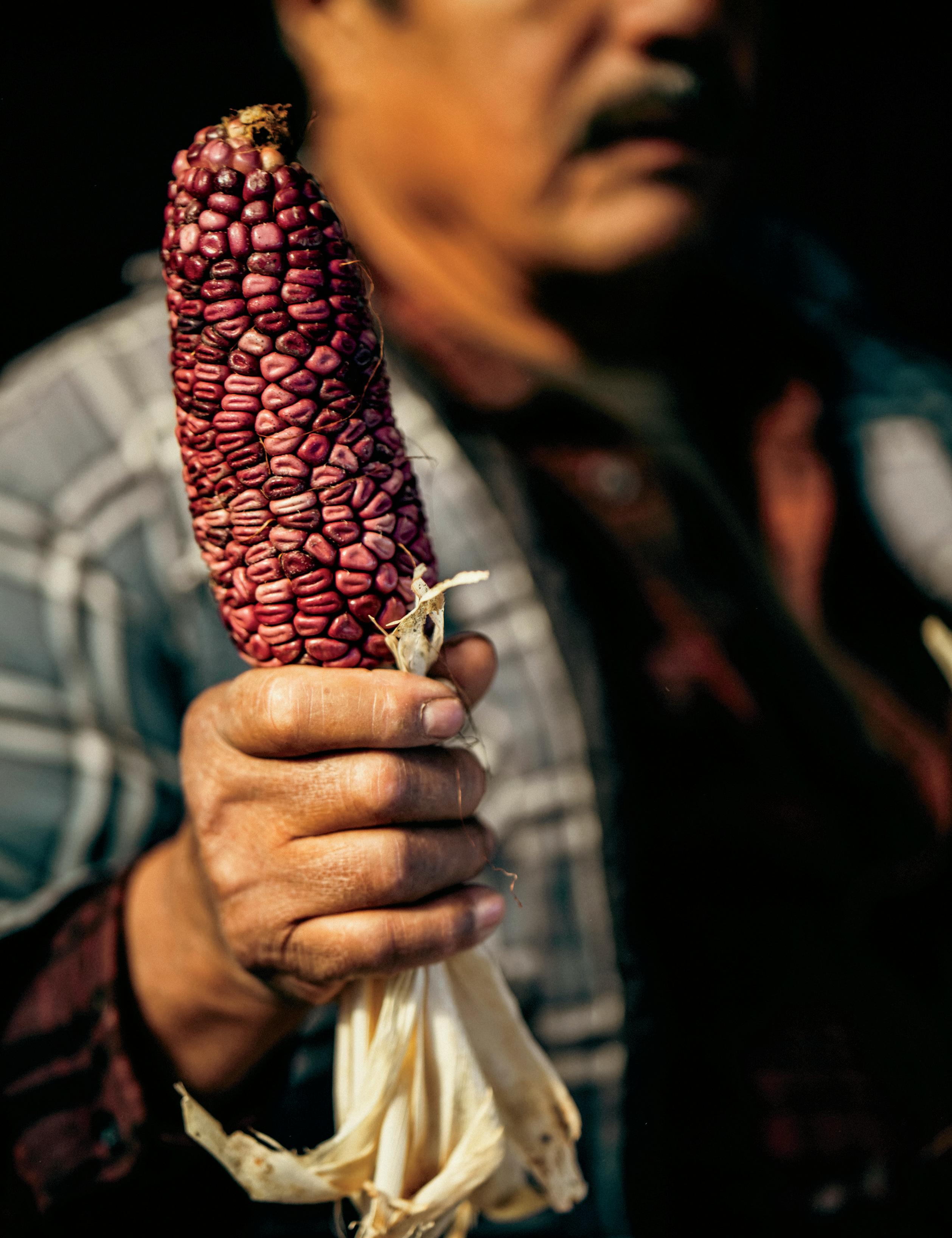 Interview by Briana Olson · Photos by Nathaniel Tetsuro Paolinelli
Interview by Briana Olson · Photos by Nathaniel Tetsuro Paolinelli
Jesus Guzman farms on about six acres split between four parcels in Nambé—one at his home and three that he leases. In addition to farming, he’s been a landscaper, a property caretaker, and a dairy worker. Among other things, he grows blue and red corn, chicos, beans, onions, peas, garlic, and, lately, drought-tolerant asparagus.
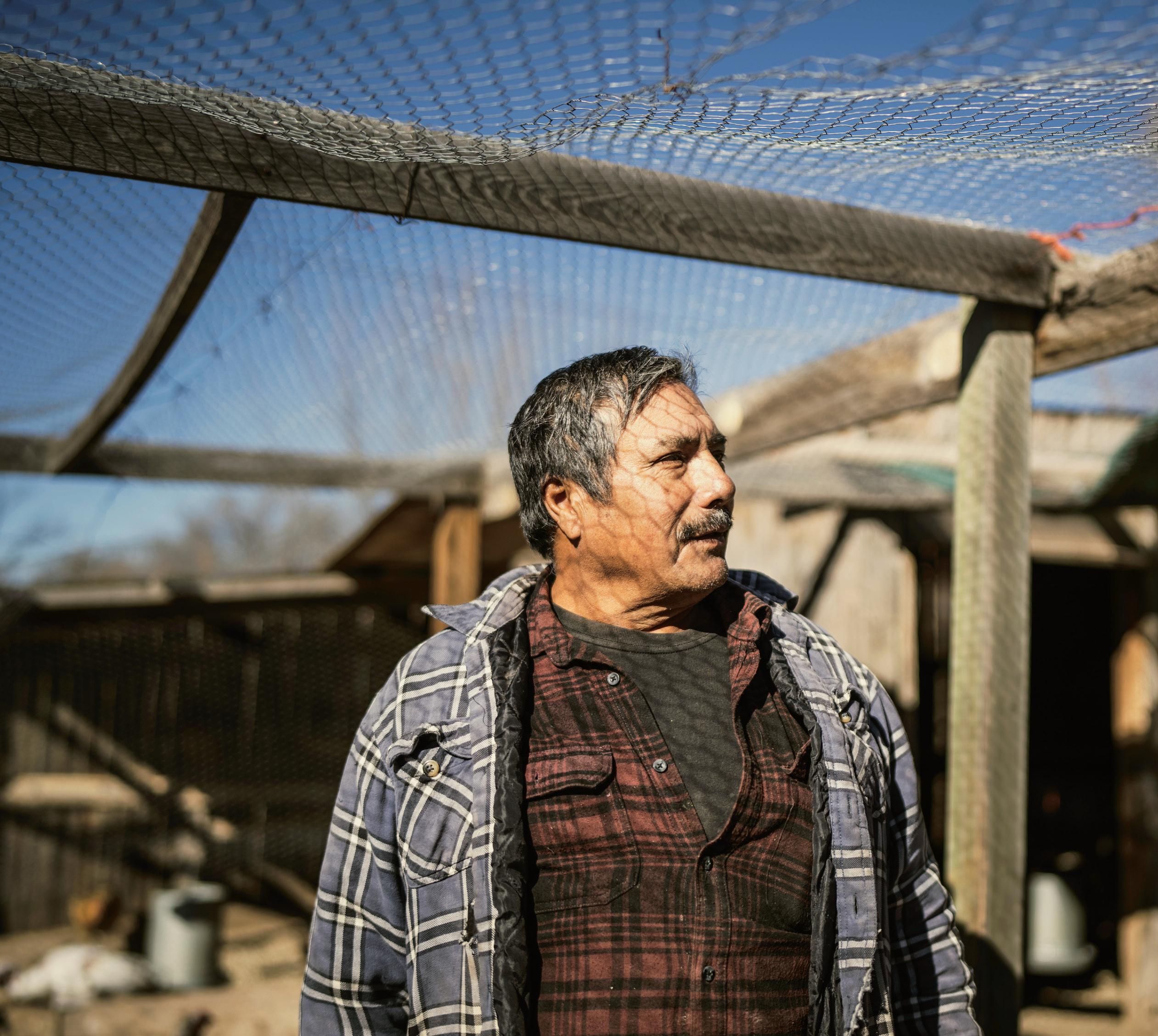
WHY FARM?
My father started me when I was seven where I grew up down in Mexico. I’m
the second kid in the family. It was me, my older sister, my dad, and my mom at that time. And you don’t work there eight hours a day. You get up at five o’clock in the morning, and if you don’t get up, somebody will get you up and take you there. And they feed you and everything, but they work you until—they give you a little time for lunch—and then when the sun goes down and you can’t see the weeds anymore, then it’s time to go home.
When I came over here, I was a twenty-twoyear-old guy. I started doing this because I like it. And I had a job, and I started doing this on the side.
I think it’s a comfortable life.
DREAMS
So then, like everybody, the dream was, I’m gonna work hard and own my own house one day. I did work hard. I never worked eight hours a day. I used to work at the dairy, start at three o’clock in the morning,
62 edible New Mexico | SPRING 2023
to eight, go to breakfast, start at nine back in the fields, to three o’clock, start back in the dairy three o’clock in the afternoon to eight or nine at night.
ACCIDENTS
When I was in Medanales, I had a property that was 2.2 acres. I had eleven cows. I had like ten goats and eight or nine sheep. I had twenty pigs. I had a couple of dogs. I had like eighty chickens. In the summer, I had to make sure I had enough hay for my cattle
and enough feed for my animals. I had a big barn built and I put everything underneath it in the summer for the winter.
Then, in 1999, I fell off a tree and I broke my back in two parts. So I got rid of the cows, I got rid of the goats, and sheep, and pigs, and I just left the chickens. I wasn’t able to go and load up my flat trailer with 120 bales of hay by myself into the field. So after that I couldn’t do it anymore.

My second accident was in 2010, I fell off a ladder and broke my right shoulder.
The last one was in 2013; since then I’ve been less of a farmer or anything else.
CLIMATE
I’m originally from a town that is called Yuriria, Guanajuato. Here, we grow with flooding. There, we used to farm with the rain, just dryland. But it rained enough to where you can harvest anything.
Here, we’ve got a shortage of water since 1996. We didn’t irrigate not even one time that year. From there, there have been bad years, somewhat good years, but never like before that. Between 1980 and 1995, we had water to throw away. The ditches were running from the first of April to the first of October. Last year, it was okay, but we’ve never had what we had in those days. I don’t know where we’re going with this as far as farming here. Now I’ve got that pond dug out for the same reason. To store water. That helps me with my seedlings when I transplant. Nowadays we get four days of water in the ditch every so often. Maybe three or four times in the whole summer. I’m trying to switch to things that grow with less water.
The sun is more intense than before. The last two to three years, I’ve been noticing that some of the plants get curled, the leaves get burned.
If this continues, it’s gonna end. There’s no way that you are going to be able to farm outside in this heat and no water. I hope that it will change.
VALUE
Especially here, we all got little gardens. We don’t got big gardens like other places. And we’re barely making it. Because you put a
lot into it to get very little off of it. If you’re gonna add every minute that you work on it, let’s say fifteen bucks an hour, and then your seeds, and then your time to go running up to the water in the middle of the night, and do all of these things, I think that people who eat my stuff should be proud of it. And say, “This guy really worked for it.”
THE FARMERS MARKET
I think we’re lucky to have customers to support us. Because we have high prices. I don’t believe that a pound of beans is worth five bucks. And I don’t believe that a pound of asparagus is worth eight dollars. I don’t believe a pound of chile will be worth thirty or forty dollars. I sell my chile powder at twenty dollars a pound, which I think is a little stiff, to tell you the truth.
I base every price on what I believe that I would be able to pay for it. I figure that the people that come to the farmers market and support us and buy our stuff, I think that they work for their money. I think most people work for what they have.
COMMUNITY
You know, a lot of people here don’t like us Mexicans. They’ve said it to myself, “People from Mexico don’t deserve to own land here.” And I said, “Anybody that can buy it with their own money, they deserve it.” They’re very proud to say, “Well, I’m an American, and I don’t own one inch of land over here.” Well, why is that my fault? How do they see it that way?
When I came over here and I started working and I started meeting people, the one thing, when I knew I wanted to be here for the rest of my life, I contribute to the community as much in the way that any citizen does. Even since I was illegal. Then I became legal, then I became a citizen. But that doesn’t mean anything—it’s just because it’s me, it’s not because I’m Mexican. If I see somebody who needs my help, then I will help. And I will do it without hesitating about what’s for me. That’s by defense of being an alien here. Hey, I did my part. I contribute to my community like a human being.
63 EDIBLENM.COM
Find Jesus Guzman at the Santa Fe Farmers’ Market.
PORTRAIT OF A FARM

64 edible New Mexico | SPRING 2023
Interview by Briana Olson · Photos by Nathaniel Tetsuro Paolinelli
Clarence Hogue and Eileen Shendo.
The Indigenous Farm Hub (IFH) cultivates seventeen acres in Corrales, with four acres in vegetable production and the remainder in hay and cover crops, providing 140 families with produce through their CSA program. The farm is not only a food source but is also a hub of learning, growth, and prosperity building. Its core initiatives include connecting language and land-based learning for students at the Native American Community Academy and other schools; working to strengthen food networks in Indigenous communities; and running a farmer residence program that supports three farmers on fair salaries every year.
PEOPLE
Clarence Hogue, farm director and director of communications and outreach: I grew up on a farm . . . it’s kind of nice that I’m back where I started, back to my roots.
Merlin Toya-Lucero, farm coordinator: Growing up, I wasn’t really into it. We had some elders back home who did farm, but that wasn’t really practiced by my generation. After maturing, after life humbling me, and learning more about the world and climate change and healthy food and eating . . . I was finally like, I get it. Farming is important. I want to do that.
Alan Brauer, farm facilitator / senior director of initiatives and programs: I grew up on a dairy farm. . . . Farming is kind of in my bones.
DJ Ladabour, FoodCorps service member: I’ve always worked around food. I’ve been a cook. Once I started farming and spending every day outside, taking care of the land, it put me back in a place where I wanted to reconnect.
Rebecca Grashuis, farm-to-school education coordinator: I started off doing traditional medicine practices when I was a kid—that was my first connection working with the land and working within Chicano culture. . . . I got into farming seven years ago. I started off with organic, small-scale urban farms because I thought that it would be easier for people in urban communities to start to build up food systems outside modern food systems that were failing us.
Eileen Shendo, beginning farmer resident for 2022: I’ve been growing with my grandpa and my family since—that’s how we were raised. I think for us as Pueblo people, in order to make our culture and identity, you have to grow. Because for one, we use corn from the moment of birth to death. If we don’t maintain that, we lose everything.
GROWING FOOD, GROWING FARMERS
Alan: We’re growing food; we’re not demonstrating how to grow food. We wanted to ignite love of learning for growing food, but we also wanted to make sure that we were at a scale that we could support people with the food. Thus sixteen acres that we have [at this site] and that we’ve been working with a landowner to purchase one piece at a time.
We want to make sure [IFH] is sustainable and we’re able to grow enough food that we can eventually make sure that the salaries for our staff and the production can make ends meet. There’s about sixty thousand farms that are considered Native-American–run in our country. I think 75 percent of them make less than $10,000 a year, and 92 percent make less than $50,000 a year. Even if $50,000 was a fair income for the farm work that you have to do, when you only have 8 percent of the population of Native farmers that are making that. . . .
So we center our farmer residence program on the vocational aspects of growing food at a production scale. Everything from planting schedules to successive planting to using different varieties of amendments to the soil to using drip tape irrigation to flood irrigation.
Rebecca: A lot of times, farming is taken as unskilled labor, whereas it’s highly skilled. There’s very few people in my age range that I know who can run a production farm like this. If we can start to allocate value to our food systems and to the importance of building resiliency within communities, especially through food, then we can start to see some really lasting change in our health and our connection to each other as people.
Merlin: I always thought farming was like, put a seed in the ground, water it, hope for the best, and it will grow. But there’s so much more to it. Work, commitment, dedication.

COMMUNITY
Eileen: The First People of New Mexico have been left out a lot in developing food systems. I’m speaking for myself, specifically as an individual from Jemez and Cochiti Pueblos. . . . In Indian Country, our food systems were one of the first means—so whether you look at how we grew or how we lived, or animals, and that sense of our livelihood—[that] were intentionally exterminated. For me a big part in our work with the Indigenous Farm Hub, not only with landowners or traditionalists who are agriculturalists but especially with Native women, is to really see how they can create an economy off what they love.
Clarence: There’s a lot of places in our state where people don’t have access to food as readily as here in Albuquerque. That’s my
65 EDIBLENM.COM
experience growing up is we had to drive at least thirty miles to get to a grocery store. So we need to start thinking about how we can work more with communities and help them strategize solutions for getting better food access and really supporting local farmers, creating systems so that the most rural communities and farmers can also contribute. The bottom line is really about getting food out to people who need it.
Merlin: Diabetes is a really big issue, especially where I’m from. Around my junior year in high school, I started realizing, I don’t want to get that—I wanted to be that [small] percent of Laguna members that aren’t diabetic and don’t have any preexisting conditions and try to be as healthy as I can.
INVESTMENT
Eileen: If people or private funders, whoever, could actually invest in people directly, or with tribes, [farming] would be more self-sustaining. Because right now, there’s millions of dollars—billions—that are going out for food system development. But [the funds] go through large nonprofits, which basically get taken out by indirect costs and overhead, and then end up [telling] farmers, “Go try to do this with $3,000.” Or give $10,000 of seed money, and hopefully it works. And I think that’s the part that is discouraging because it’s really not meeting the need when we know it could. And it’s not supporting systems that have been effective for time immemorial.
Rebecca: If we can build interest, if you start getting kids connected in elementary school—how do you grow a plant? What do you do with compost? What’s in a watershed? And then in high school we have a focus like, if you want to get into agriculture, there’s value in it. There’s respect in it. There’s connection with your ancestors and there’s connection with the generations you’re feeding.
DJ: Farming is a huge aspect in my everyday life—I’m thinking about saving seeds and planning ahead for not only this place but my grandma’s house and other people’s gardens that I’m helping out with.
CLIMATE
Clarence: Water is a big part of what we do here, so if we don’t have the water, we can’t
do a whole lot. We have a big irrigation system over there, we have a well that we use, that’s where we get the water to do a lot of our drip tape. We’re lucky that we can do that—a lot of places don’t have that.

Last summer, they told us we were probably only going to get two waterings [from the acequia], maybe May and June, and that was it. . . . They only allow you sixteen hours the one time you get water, and they really monitor you. Even if you’re ending at midnight. Based on that, you know something is different. Something is changing.
CROPS
Clarence: We did really good with onions. Eileen: Tomatoes, chard, kale.
Clarence: Corn—we did blue corn and white corn, native corn— Eileen: Chiles.
DJ: Sweet potatoes, peanuts, big leaf kale. We have a vegetable preference survey that we give out to FoodCorps.
Clarence: Certain things grow better at different times. Like peas. But some things hold you through the summer. Even that is an education.
indigenousfarmhub.org

66 edible New Mexico | SPRING 2023
Merlin: I really like the labor; I like not just working with my hands but getting farmer strength. Learning how to properly hold a shovel. It’s rewarding.

DJ: After tasting the difference, going through the whole process of growing [produce] and using it, it’s a lot better. It just tastes a lot better. It feels a lot better too.
Above, left to right: Clarence Hogue, Rebecca Grashuis, Eileen Shendo, and Merlin Toya-Lucero.
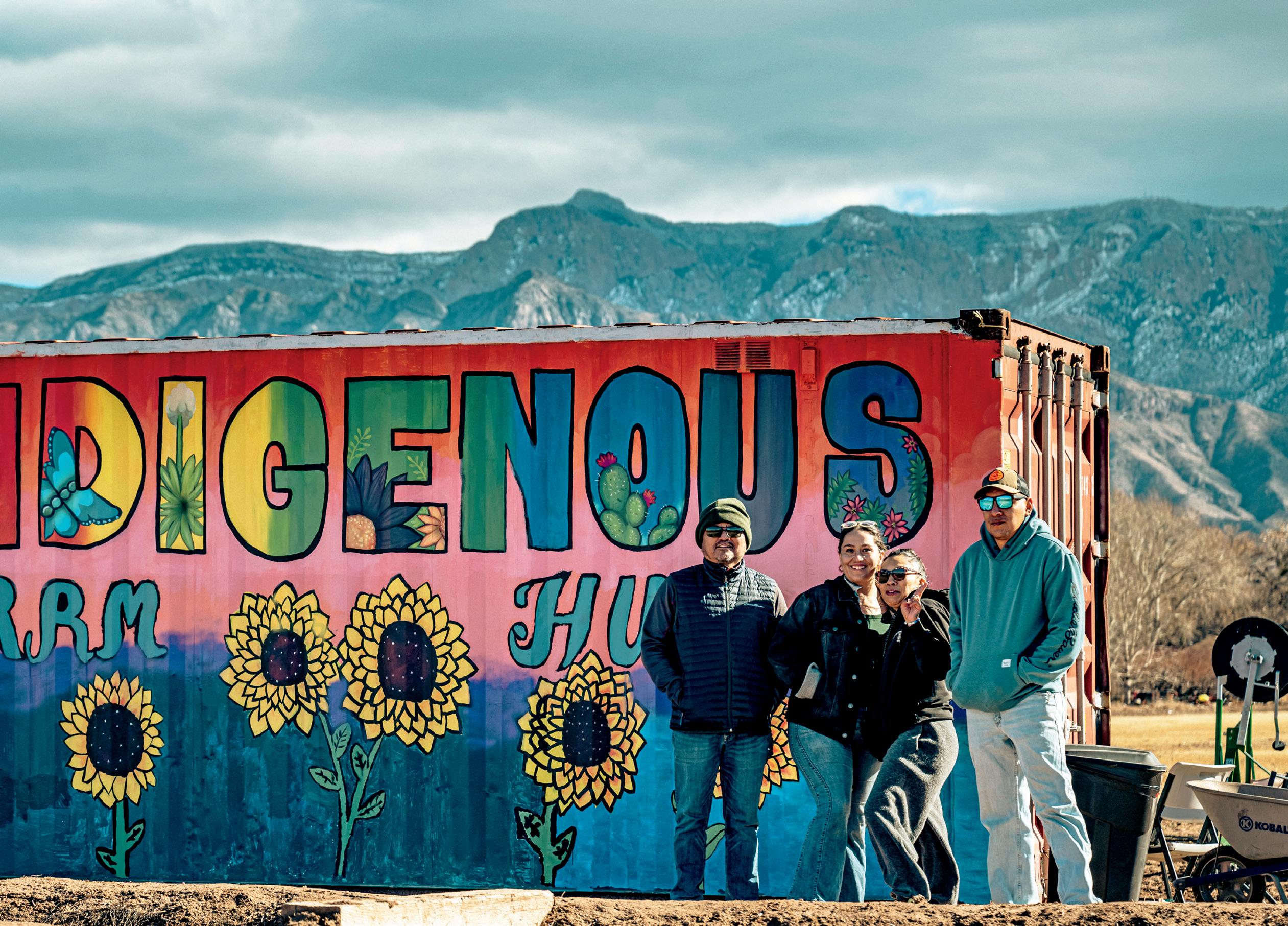
Left: DJ Ladabour.
Right: Alan Brauer.
Note: These interviews have been edited for clarity and length. Find longer versions at ediblenm.com.
67 EDIBLENM.COM
REFLECTIONS FROM A FARMER IN SOUTHERN NEW MEXICO
 By Shahid Mustafa · Photos by Stephanie Cameron
By Shahid Mustafa · Photos by Stephanie Cameron
Somewhere I’d heard that the river flowed almost 1,900 miles from southern Colorado, traversing New Mexico, Texas, and Mexico directly into the Gulf of Mexico. So when I finally had the opportunity to visit the river, I wasn’t prepared for what I saw, or in this case, what I didn’t see.
“S
Shahid Mustafa in the riverbed of the Rio Grande after a rainstorm.
“Water is life” is an adage both simple and profound in its truth. As a person attempting to produce food, I embrace it as a philosophy and as a practice. So critical and integral to the survival of the majority of life on our planet is water, yet so easily taken for granted as a static and widely available resource.
I have what I consider a very complicated relationship with water. Growing up in Chicago, I often marveled at how vast and powerful Lake Michigan appeared. Standing on the shore, it was easy to be overcome by its awesomeness. I almost drowned in a pool as a child, so sometimes my amazement was coupled with the fear of how powerful and overwhelming a large body of water could be. For the majority of my life, water scarcity never came to mind. I took for granted the annual winter snow, and the seasonal rains of the spring and summer. If I’m honest, I’ll admit that for the most part, I was just plain annoyed with spring showers. Because snow inevitably turned into a hard-packed, frozen, slippery, dangerous obstacle in the path of my daily life, that subsequently melted into a combination of sand, rock salt, mud, and an assortment of contributions from domestic pets, I didn’t look forward to its falling.
When I moved to Las Cruces in January 2006, I couldn’t wait to hike the Organ Mountains and sit next to the mighty Rio Grande River that I had heard so much about. The hike up the mountain was all that I thought it would be—the visit to the Rio Grande, though, not so much. It was completely dry. Somewhere I’d heard that the river flowed almost 1,900 miles from southern Colorado, traversing New Mexico, Texas, and Mexico directly into the Gulf of Mexico. So when I finally had the opportunity to visit the river, I wasn’t prepared for what I saw, or in this case, what I didn’t see. I walked down the bank of the river and “waded” through the sand and sediment to the center of the riverbed. It turned out that, as with many things I’d learned in history, the lore of the mightiness of the Rio Grande was a matter of subjectivity.
Experiencing my first monsoon season, it became apparent that the natural landscape of the desert doesn’t lend itself to efficient water capture. The main road that I regularly rode my bike to work on every morning became what appeared to be a river during the heavy rains, as there was no drainage infrastructure to control runoff or divert the water from the streets. There was pooling in many areas, which provided the conditions for massive waves to be created as vehicles navigated the thoroughfare. What was most interesting, though, was the evaporative rate that, within the span of my eight-hour workday, made it appear that nary a drop of rain had fallen.
Eventually, I learned that the water of the Rio Grande was being impounded about eighty miles north of Las Cruces at the Elephant Butte Dam near Truth or Consequences. The river was dammed in the 1910s to help mitigate issues related to agriculture, such as runoff, evaporation during droughts, and the inequitable appropriation of water. Years later, in 1939, the Rio Grande Compact was ratified between the states of Colorado, New Mexico, and Texas. It was established for the purpose of effecting an equitable apportionment of waters between these states. The Rio Grande is currently under the authority of the United States Bureau of Reclamation through
the Rio Grande Project, and the Elephant Butte Irrigation District (EBID) manages the river’s water provided to the southernmost part of the state. (The Middle Rio Grande Conservancy District manages the river and irrigation systems in central New Mexico.) For over one hundred years, EBID has been in charge of the surface water of New Mexico’s portion of the Rio Grande Project, meaning the irrigation district operates and maintains the diversion canals, ditches, and drains that provide water for fields of chile, potatoes, alfalfa, and other crops farmed in the Rincon and Mesilla Valleys.
Because it is being fed by the melting snowpack from the mountains of southern Colorado, the Rio Grande has always been impacted by changes in weather patterns. The historical conditions that have affected the availability of surface water throughout the centuries have been exacerbated by both regional population growth and the recent warming weather trends. These conditions have created an untenable situation for New Mexico agricultural producers, especially those wholly dependent on surface water irrigation south of the dam.
From information obtained from EBID on historic water allocations, there has been a significant reduction in available surface water. Between 1979 and 2002, their allocations remained steady at 36 inches, or 3 acre-feet per year. Subsequently, the allocations have varied from as high as 36 inches in 2008 to as low as 3 inches in 2013. The average allotment over the past twenty years has been around 14 inches. According to data obtained from EBID, the allocation in 2022 was 6 inches. To offer some perspective, pecan trees, which are a naturally heavily water-dependent crop, require about 4 acre-feet per year, so the balance of water necessary short of the allotment must come from wells supplied by groundwater aquifers, which are restored by surface water. Well water from shallow wells tends to be brackish, which means it contains a high level of dissolved solids, making it high in salts. When salt levels are high in the water, most plants have a difficult time taking up the water; this produces a drought-like effect, causing the plants to wilt or die. Producers who are heavily dependent on well water rely on available surface water to flood and push accumulated solids farther away from the roots of their crops. The reduced surface water availability puts their crop production in jeopardy of lesser yields or irreversible crop loss.
The challenge of managing water distribution under current conditions is widespread. Not only are individual farmers struggling with decreased availability, but there is also dispute at the state and federal level as to what the solution should be. In 2013, Texas brought a case to the US Supreme Court against New Mexico and Colorado that alleges farmers using wells to irrigate their crops are depleting the Rio Grande water that New Mexico is required to deliver to Texas under the previous Rio Grande Compact. The decade-long case has been wrought with counterclaims and disputes, requiring input from entities including multiple water districts, the cities of El Paso and Las Cruces, the state of New Mexico, and farmers associations. A pending agreement has been reached, and at the time this story went to press was awaiting acceptance by the Supreme Court.
Perhaps due to the pending litigation, or the politicization of the topic of climate change, it has been hard to find producers who are
69 EDIBLENM.COM
willing to go on record to discuss their personal experience with water allocation, for fear of some level of repercussion. I find it strange that something like that would even be a consideration, but in my discussions with the few I have had the pleasure of talking to, I have concluded that we are facing a monumental issue that, considering its potential impact, seems relatively ignored by a large section of the general public. Population growth continues, and with growth comes greater demand on resources and infrastructure.
Sam Calhoun has been farming orchards for forty-four years. His company, Calhoun’s Farm Services, is a custom service organization that works with orchards. Calhoun’s, based in Anthony, does a lot of custom work to establish orchards from La Union to La Mesa. According to Calhoun, “From 1980 to 2000, we had, for the most part, all the water we wanted. Irrigation was mostly flooded. We didn’t know how good we had it.” Now most farms are heavily dependent on groundwater from wells they have had installed. Calhoun says that the most obvious impact that he sees in response to the reduced allotment is farmers’ increased costs to continue to operate. “Everybody has had to spend a lot of money on the infrastructure. There are more and more people using drip tape, subsurface irrigation, and sprinklers in orchards. The onion and lettuce market is mostly all drip tape.” On his orchards, he has added subsurface drip irrigation, which incorporates a buried drip irrigation tube to evenly distribute water and reduce evaporative rates. His orchard is not 100 percent drip irrigated, but he has noticed the efficiencies in incorporating the system. “It has helped our efficiency in very sandy soils and has helped our efficiency as far as timing. On extremely hot days, we can deliver water quicker.” When asked about what his plans are in regard to dealing with the impact of reduced allotments, Calhoun said, “We think one day it’ll come back, but nobody knows when that’s going to happen. We hope it snows again.”
As critical a resource as water is to our daily lives, especially in the desert of the Southwest, I am always surprised at the level at which most of us take it for granted. Even small farmers such as myself get

too comfortable with the anticipated availability of water. Many of us have implemented drip irrigation systems to conserve water, and try to practice farming methods that help develop healthy soils, which support water retention. But the fact is we are always at the mercy of environmental conditions largely outside of our control. The challenge of year-round vegetable production relying mostly on well water has led me to appreciate rainfall in a way that I never have before.
In December, I attended a Zoom webinar hosted by Professor Geno A. Picchioni from the Department of Plant and Environmental Sciences at New Mexico State University. The subject was the use of saline groundwaters and their effects on growth and secondary metabolites such as antioxidants in several native halophytes, which are salt-tolerant plant species. Picchioni presented some encouraging data, which supported the possibility of there being benefits in planting crops, such as quail bush and four-wing saltbush, that produce secondary metabolites for dietary supplements. This suggests that some functional food additives would actually thrive in the salty soils that we are likely to have to contend with moving forward. But still, I long for the monsoon season that I haven’t experienced since 2006. I’m somewhat saddened by the sight of the dry bed of the Rio Grande every time I have the chance to drive over a bridge that crosses it, and I wonder how much of the mineralization that clogs my irrigation emitters and builds up on my showerheads and faucets affects my personal biology in the way I see it affecting my vegetable crops.
Again, I return to the adage profound in both its simplicity and truth: water is life. As we continue to choose to inhabit a region whose geological and vegetative landscape reflects its historical experience with long periods of drought, and occasional abundant rainfall, we must face that we might have to consider adjustments to how we all manage our use of water and what our expectations might be. The ultimate result may be completely out of our control, but we can no longer ignore the long-term effects that will be determined by how responsibly we regard and collectively steward this most critical and finite resource.
70 edible New Mexico | SPRING 2023
Discrimination against marginalized groups in agriculture negatively affects all Americans by limiting the opportunities for farmers, workers, and consumers.
AFT is raising up diverse voices in agriculture, because we believe diversity contributes to a more resilient agricultural system, a stronger economy, and a more equitable society.


71 EDIBLENM.COM
Get fresh updates on our work to ensure the future of agriculture includes
Americans.
At American Farmland Trust, we believe agriculture is strengthened through diversity.
all
farmland.org
LOCAL SOURCE GUIDE
CANNABIS
Carver Family Farm
No-till, hand-trimmed, organically grown cannabis producer and dispensary. 8917 Adams, Albuquerque, 505-508-5910, carverfamilyfarm.com
KURE
We pride ourselves on providing a unique, friendly, and welcoming environment.
220 N Guadalupe, Santa Fe, 505-930-5339, kureforlife.com
The Herb Taxi
Local cannabis delivery for medical and recreational consumers. theherbtaxi.com
FOOD ARTISANS / RETAILERS
Barrio Brinery
Bringing fine fermented foods to Santa Fe. 1413-B W Alameda, Santa Fe, 505-699-9812, barriobrinery.com
Bluefly Farms
2506 Washington St NE, Albuquerque, 505510-1837, blueflyfarms.com
Bountiful Cow Cheese Company
Purveyors of fine cheese, meats, and provisions from around the world. 505-473-7911, B-cow.com
Del Valle Pecans
From our southern New Mexico orchards to your kitchen. Order online. 575-524-1867, delvallepecans.com
Eldora Chocolate
Eldora crafts chocolate using natural, organic, and fair-trade ingredients. 8114 Edith NE, Albuquerque, 505-433-4076, eldorachocolate.com
Heidi's Raspberry Farm
Sumptuous, organic raspberry jams available throughout New Mexico and online! 505-898-1784, heidisraspberryfarm.com
La Montañita Co-op
New Mexico's largest community-owned, natural, and organic food market. Locations in Albuquerque, Gallup, and Santa Fe. lamontanita.coop
Mouse Hole Cheese Shop
Itty-bitty cheese shop in ABQ. 300 Broadway NE, Ste A, Albuquerque, 505-554-2994, mouseholeabq.square.site
New Mexico Harvest
A community of people that actively invests in our food system. Eat local. Eat seasonal.
Eat outside the box stores. Delivering across New Mexico. newmexicoharvest.com
Owl Peak Farm
Grains grown and milled in La Madera. Order online at owlpeakfarm.com
Skarsgard Farms
Delivering fresh, local, and organically grown produce and natural groceries to doorsteps across New Mexico. 505-681-4060, skarsgardfarms.com
Susan's Fine Wine & Spirits
Your local liquor store in Santa Fe. 632 Auga Fria, sfwineandspirits.com
Vigil's Beef Jerky
All natural, preservative free, and made with only the best local ingredients. 7625 Second Street NW, Albuquerque, 505-867-3283, vigilsbeefjerky.com
HEALTH & WELLNESS
Daisy's Holistic Health
We offer a wide range of herbs, vitamins, supplements, and high-pH H2O. 4056 Cerrillos, Unit D-1, Santa Fe, 505-780-8687, daisysholistichealth.com
Desert Sol Alchemy
Acupuncture and classical Chinese medicine. Now accepting patients in Albuquerque and Santa Fe. 505-475-7855, desertsolalchemy.com
SageWork Organics
Topical magnesium, herbal remedies, and more. 5401 Lomas NE, Ste D, Albuquerque, sageworkorganics.com
LODGING
Heritage Hotels and Resorts
Hotels in Albuquerque, Santa Fe, Taos, and Las Cruces. hhandr.com
Los Poblanos Historic Inn & Organic Farm
4803 Rio Grande NW, Los Ranchos de Albuquerque, 505-344-9297, lospoblanos.com
Rosewood Inn of the Anasazi
113 Washington, Santa Fe, 505-988-3030
Sarabande B & B
5637 Rio Grande NW, Albuquerque, 505-348-5593, sarabandebnb.com
The Parador
220 W Manhattan, Santa Fe, 505-988-1177, elparadero.com
NURSERIES & SERVICES
Alameda Greenhouse
Vggies, fruit trees, flowers, shrubs, and perennials. 9515 Fourth Street NW, Albuquerque, 505-898-3562, alamedagreenhouseabq.com
Grow Y’Own
Year-round cedar raised beds with hoops and covers. 505-466-0393, raisedbed.biz
Osuna Nursery
A family-owned and -operated nursery, gardening center, and landscaping company. 501 Osuna NE, Albuquerque, 505-345-6644, osunanursery.com
Payne’s Nursery
Payne’s North, 304 Camino Alire, 505-988-8011; Payne’s South, 715 St Michael’s, 505-988-626; Payne’s Organic Soil Yard, 6037 Agua Fria, 505-424-0336; Paynes.com
ORGANIZATIONS & EDUCATION
Museum of New Mexico Foundation
Philanthropic support for our state’s cultural heritage. museumfoundation.org
Slow Food Santa Fe
Slow Food is about enjoying food and the community it creates. Intrigued? Learn more at slowfoodsantafe.org.
OTHER SERVICES
Rio Grande Credit Union
Multiple locations in Albuquerque. riograndecu.org
RETAILERS
Black Diamond Curio
Modern mercantile in downtown Santa Fe. 219 W San Francisco, Santa Fe, 505-390-2025, blackdiamondcurio.com
Flyby Provisions
Enjoy shopping for boutique local New Mexico gifts—thoughtfully selected and packaged with care. 201 Coal SW, Albuquerque, flybyprovisions.com
Kei & Molly Textiles
Hand-printed kitchen linens and curated gifts. 4400 Silver SE, Ste A, Albuquerque, keiandmolly.com
Kitchenality
Irresistible and gently used gourmet cooking and entertaining ware. 1222 Siler, Santa Fe, 505-471-7780, kitchenangels.org
Living Threads
100% natural ingredients from around the world. 1610 Lena, Ste D, Santa Fe, 505-6637784, livingthreads.org
Mountain Standard Time
High-desert bodega and corner store. 504 Galisteo, Santa Fe, 505-699-1067, mtnstd.com
Sarabande Home
We have a passion for finding the perfect gift. 4022 Rio Grande NW, Albuquerque, 505-344-1253, sarabandehome.com
The Next Best Thing to Being There
An eclectic shop for handmade products. 1315 Mountain NW, Albuquerque, 505-433-3204, beingthereabq.com
The Perfect Gift Shoppe
The perfect place to find something for everyone. 901 Rio Grande NW, Ste D-126, Albuquerque, theperfectgiftshoppe.com
Tin-Nee-Ann Trading Co.
Family operated and family friendly since 1973. 923 Cerrillos, Santa Fe, 505-988-1630, tin-nee-ann-trading-co.myshopify.com
72 edible New Mexico | SPRING 2023











B URGERS D FRIES GRASS-FED & DARN HEALTHY www.grassburger.com Aw d winn since 2017 5401 lomas blvd ne ste.d F resh and sweet organic pecans , F rom our southern new mexico orchards to your kitchen order online at delvallepecans.com 575.524.1867 Genuine Food & Drink Enchanting, Dusty... Wild West Style 28 MAIN STREET LOS CERRILLOS 505.438.1821 Thursday - Sunday blackbirdsaloon.com Acupuncture + Classical Chinese Medicine Now accepting patients in Albuquerque + Santa Fe Desertsolalchemy@gmail.com desertsolalchemy.com | 505.475.7855 Mouse Hole CheeseShop 300 Broadway Blvd NE, Ste A, Albuquerque 505.554.2994 mouseholeabq.square.site (The Albuquerque Journal)


Get your weekly taste of at thebitenm.com New Mexico’s Independent Culinary Authority
& DRINK LOCAL GUIDE
ALBUQUERQUE RESTAURANTS
Campo at Los Poblanos
Historic Inn & Organic Farm
Rio Grande Valley cuisine rooted in seasonal organic ingredients from our own farm. 4803 Rio Grande NW, 505-344-9297, lospoblanos.com

Cutbow Coffee

One of the nation’s most accomplished artisan coffee roasters, Paul Gallegos. 1208 Rio Grande NW, 505-355-5563, cutbowcoffee.com
Farm & Table
Enjoy delectable seasonal dishes created from scratch, sourced from local farmers and our beautiful on-site farm. 8917 Fourth Street NW, 505-503-7124, farmandtablenm.com
Grassburger
The feel-good, award-winning burger—100% grassfed beef, vegan, or poultry! 11225 Montgomery, 505-200-0571, and 5600 Coors NW, Ste 3, 505-361-2368, eatgrassburger.com
Mata G Vegetarian Kitchen
International vegan and vegetarian cuisine. 116 Amherst SE, 505-266-6374, mata-g.com
Mesa Provisions
A playful, Southwest-inspired menu. 3120 Central SE, Albuquerque, 505-494-5264, mesaprovisions.com
Savoy Bar & Grill
California wine country in the Northeast Heights. Farm-to-table dining and a casual patio. 10601 Montgomery NE, 505-294-9463, savoyabq.com
Sawmill Market
Eclectic collection of bars and eateries, plus an expansive courtyard. 1909 Bellamah NW, sawmillmarket.com
Seasons Rotisserie & Grill
Oak-fired grill, local and seasonal ingredients, and the best patio dining in Old Town. 2031 Mountain NW, 505-766-5100, seasonsabq.com
Roti N.M. Rotisserie Chicken
Experience chef-driven, scratch-made rotisserie comfort food at Albuquerque’s Sawmill Market. 1909 Bellamah NW, 505-814-3653, rotinm.com
The Grove Cafe & Market
The Grove features a bustling café experience serving breakfast, brunch, and lunch. 600 Central SE, 505-248-9800, thegrovecafemarket.com
The Shop Breakfast & Lunch
Serving breakfast and lunch Wednesday through Sunday. 2933 Monte Vista NE, 505-433-2795, theshopabq.com

Trifecta Coffee Company
We roast coffee and brew in unique ways. 413 Montaño NE, 505-803-7579, trifectacoffeeco.com
SANTA FE RESTAURANTS




Anasazi Restaurant & Bar
Contemporary American cuisine inspired by locally sourced seasonal ingredients. 113 Washington, 505-988-3030, innoftheanasazi.com
Arroyo Vino
We serve progressive American fare inspired by our on-premise garden and local purveyors. 218 Camino La Tierra, 505-983-2100, arroyovino.com
Cafecito
Cafecito is a family-owned business blending cultures to bring you a delicious menu in a beautiful gathering space. 922 Shoofly, 505-310-0089, cafecitosantafe.com
75 EDIBLENM.COM cafecito (505) 310-0089 | 922 Shoofly St. SF, NM cafecitosantafe.com | @cafecito.santafe BREAKFAST, LUNCH, DINNER & BRUNCH
www.b-cow.com 505-473-7911 Est. 1984 Wholesale Specialty Cheese/Meats/Provisions 300+ Cheeses from around the World
EAT
4056 Cerrillos Road, Unit D-1, Santa Fe daisysholistichealth.com ∙ 505-780-8687
Daisy’s takes a unique approach to Holistic Health. We offer a wide range of Bulk Herbs, Vitamins, Supplements, and High pH H2O.
Daisy’s Holistic Health is locally owned and dedicated to great customer service.
Here’s your opportunity to recognize the hard work your favorite food and farming organizations and businesses have put into championing farm-fresh, locally produced food in New Mexico.

NOMINATIONS are open through March 29, 2023. VOTING will be open from April 7 through May 7. LOCAL HEROES are announced on July 1.

• e dible NEWMEXICO •
SANTA FE RESTAURANTS cont . . .

Iconik Coffee Roasters
Amazing food, unique coffees roasted on-site, and superfast high-speed internet.
314 S Guadalupe and 1600 Lena, 505-428-0996, iconikcoffee.com
La Casa Sena

Mediterranean-inspired cuisine, craft cocktails, and an award-winning wine list, located in the beautiful courtyard oasis of historic Sena Plaza. 125 East Palace, 505-988-9232, lacasasena.com
La Mama Santa Fe
Coffee, natural wine, all-day menu, grocery, and flowers. 225 East Marcy Street, lamamasantafe.com
Loyal Hound
Locally sourced modern comfort food paired with craft beer, cider, and wine. 730 St Michaels, 505-471-0440, loyalhoundpub.com
Ohori’s Coffee Roasters
Locally roasted coffee beans, gifts, and gathering. 505 Cerrillos and 1098 St Francis, 505-982-9692, ohoriscoffee.com
Paper Dosa
Bringing fresh, authentic homestyle South Indian dishes to your table. 551 W Cordova, 505-930-5521, paper-dosa.com
Pranzo Italian Grill
Upscale Italian cuisine. 321 Johnson, 505-984-2645, pranzoitaliangrill.com


Radish & Rye
Farm-inspired cuisine: simple yet innovative food and drinks sourced locally whenever possible. 505 Cerrillos, 505-930-5325, radishandrye.com
Red Sage
Red Sage at Hilton Santa Fe Buffalo Thunder. Fare rotates seasonally. 20 Buffalo Thunder Trail, 505-819-2056, redsage-sf.com
Rio Chama Prime Steakhouse
Refined ranch space known for prime rib and filet mignon along with a popular bar and happy hour. 414 Old Santa Fe Trail, 505-955-0765, riochamasantafe.com
Rustica
Sophisticated yet casual—Rustica serves fresh, homemade Italian food. 2547 Camino Entrada, 505-780-5279, rusticasantafe.com
TerraCotta
Seasonally changing, globally inspired cuisine and an extensive, value-priced wine list. 304 Johnson, 505-989-1166, terracottawinebistro.com
The Compound Restaurant
Chef Mark Kiffin preserves a landmark tradition of elegant food and service at his Canyon Road institution. 653 Canyon Road, 505-982-4353, compoundrestaurant.com

Wild Leaven Bakery
Artisan sourdough bread and baked goods using organic, local grains and ingredients. 130 N Guadalupe, wildleavenbakery.com
77 EDIBLENM.COM 225 East Marcy St natural wine · coffee · all day menu 923 Cerrillos Road at St. Francis Dr 505.988.1630 10–5, Mon thru Sat ∙ tinneeann2@gmail.com TIN-NEE-ANN Trading Co. Family Operated - Family Friendly Since 1973 Loyal locals love us. come see why!
NEW MEXICO
COCKTAIL
WEEK
JUNE 210, 2023
The Liquid Muse has teamed up with Edible New Mexico to spotlight local bars and restaurants offering cocktail and culinary experiences during New Mexico Cocktail Week, which will be paired with education and signature events.

Restaurants, bars, and tasting rooms across New Mexico are invited to participate.
Toast-worthy Celebrations Across The Land of Enchantment nmcocktailweek.com
We roast coffee and brew it uniquely, utilizing some of the best methods available. All our baked goods, sweet and savory, are made in-house.

1413-B West Alameda, Santa Fe www.barriobrinery.com ∙ 505-699-9812
SANTA FE
SLOWFOODSANTAFE.ORG

Chef and owner Kevin Bladergroen brings together fresh ingredients, artistic vision, and European flair in every dish. Award-winning wine list.
Creative Casual Cuisine 221 Highway 165, Placitas 505-771-0695, www.bladesbistro.com

GREATER NEW MEXICO RESTAURANTS


Black Bird Saloon
Genuine food and drink, Wild West style. 28 Main St, Los Cerrillos, 505-438-1821, blackbirdsaloon.com
Blades’ Bistro

Chef Kevin Bladergroen brings together fine and fresh ingredients, artistic vision, and European flair in every dish. 221 Hwy 165, Placitas, 505-771-0695, bladesbistro.com
Little Toad Creek Brewery & Distillery Taste Southwest New Mexico.
200 N Bullard St, Silver City, 575-956-6144, and 119 N Main St, Las Cruces, 575-556-9934, littletoadcreek.com
Michael’s Kitchen Restaurant and Bakery
Regionally inspired eats with a tongue-incheek menu in a casual space. 304-C N Pueblo, Taos, 575-758-4178, michaelskitchen.com
Pajarito Brewpub & Grill
Open for lunch Tuesday–Sunday. Open for dinner every day. 30 craft beers on tap. 614 Trinity Dr, Los Alamos, 505-662-8877, pajaritobrewpubandgrill.com
Pig + Fig
Comfort food for everyone using highquality, ethically sourced, seasonal ingredients. 11 Sherwood Blvd, White Rock, 505-672-2742, pigandfigcafe.com
Prairie Hill Café
Local farm-to-table restaurant that serves classic Americana comfort food with an epicurean flare. 230 Plaza St, Las Vegas, 505-434-0022, prairiehillcafe.com
The Skillet
American, Southwest, vegetarian friendly. 619 Twelfth Street, Las Vegas, 505-563-0477, giant-skillet.com
Wild Leaven Bakery
216 Paseo Del Pueblo Norte, Taos, wildleavenbakery.com

79 EDIBLENM.COM
Linking the pleasure of good food with local community.
Barrio Brinery SANTAFE NewMexico
Santa Fe's source for fine fermented foods. Our lacto-fermented pickles, sauerkraut, and escabeche are hand-crafted in small batches.
413 Montano NE, Albuquerque 505-803-7579, trifectacoffeeco.com
TRIFECT A COFFEE COMP ANY
COCKTAIL WEEK NEW
TACO & COCKTAIL COMPETITION
TACO WARS RETURNS TO SANTA FE ON JUNE 3 · nmcocktailweek.com
MEXICO
The priceless support of these businesses and organizations helps to grow and sustain edible New Mexico .
DIAZ KITCHEN & SUSHI BAR
With twenty years of experience as a sushi chef, Manuel Diaz Gonzales and his wife, Tara, opened Diaz Kitchen & Sushi Bar in downtown Albuquerque in July 2022. Manuel began his career in Torreón, Mexico, then spent sixteen years working for the Sushi King restaurants. Passionate about sushi, he is excited to put his twist on the Japanese fare. In addition to temaki and classic sushi offerings, Diaz Kitchen also has panfried noodles, dumplings, and soups. For breakfast, their creative offerings include Bacon Green Chile Cheese Rolls and California Sushi Omelets.
118 Central SW, Albuquerque, 505-369-1747
diazkitchenandsushibar.com


The Last Bite is brought to you by Rio Grande Credit Union and highlights New Mexico’s food entrepreneurs and small businesses.


80
LAST BITE
Top left: Fitness Roll with spicy tuna wrapped in cucumber. Bottom left: Dragon Roll topped with eel. Top right: Gyoza. Bottom right: Manuel Diaz Gonzales. Photos by Stephanie Cameron.
Add Some Flavor To Your Finances.


At RGCU, we’re anything but bland. Savor the flavor of a checking account that pays you money market rates on your balances - AND rewards.
Ingredients (a.k.a. the fine print): Federally insured by NCUA. We don’t make you jump through a bunch of cumbersome hoops to earn rewards or dividends. You don’t have to do things like have a bunch of transactions, or eStatements to qualify. You’ll earn dividends on balances $500 and greater. There is a monthly fee if you don’t keep a daily balance of $500. You can waive that if you’re over 55 years of age. So, if you don’t plan to keep $500 in the account and you’re younger than 55, get our Free Checking account. It pays rewards too. In other words, everything you want and need, and nothing you don’t.

Dividend Checking + Rewards. RioGrandeCU.org/Zia 505.262.1401







A R R O Y O V I N O C O M 5 : 0 0 P M ARROYO VINO Restaurant and Wine Shop 11 Years Serving Santa Fe! @ | 2 1 8 5 0 5 9 8 3 2 1 0 0 | A R R O Y O V I N O WINE SHOP: TUESDAY–SATURDAY 11AM-–7PM

























































 Words and Photos by Ungelbah Dávila-Shivers
Words and Photos by Ungelbah Dávila-Shivers


























 By Candolin Cook
By Candolin Cook














































































































 Interview by Briana Olson · Photos by Nathaniel Tetsuro Paolinelli
Interview by Briana Olson · Photos by Nathaniel Tetsuro Paolinelli








 By Shahid Mustafa · Photos by Stephanie Cameron
By Shahid Mustafa · Photos by Stephanie Cameron
















































